AVIATION INTERNATIONAL NEWS
OEMS: THE FIRST LEAR JETS, THEN AND NOW
SAFETY: WHO'S RUNNING OFF THE RUNWAY
AVIONICS: IS IT TIME FOR NIGHT VISION GOGGLES?
Special Report: AVIONICS SUPPORT
Oshkosh!
A record-breaking biggest and best-ever EAA AirVenture

SEPTEMBER 2023 | Vol. 52 No. 9 | AINonline.com $9.00



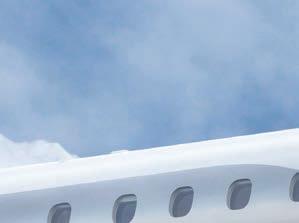
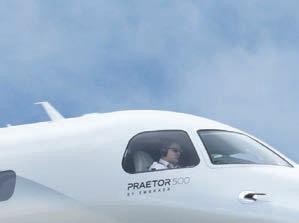

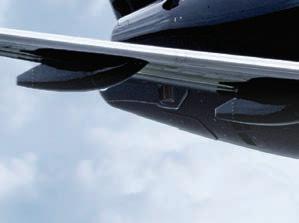

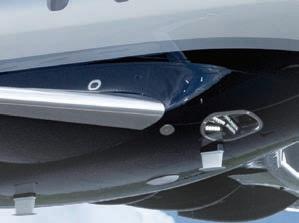
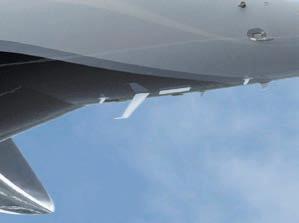

LARGER JET TECHNOLOGY SMALLER CARBON FOOTPRINT The only midsize with full fly-by-wire and Active Turbulence Reduction +1 321 751 5050 | embraer.com/praetor500
18 Legacy Tails: Lear Jet 23— The Birth of a Legend
22 AIN Product Support Survey: Avionics
4 NTSB: Night close call blamed on Learjet flight crew
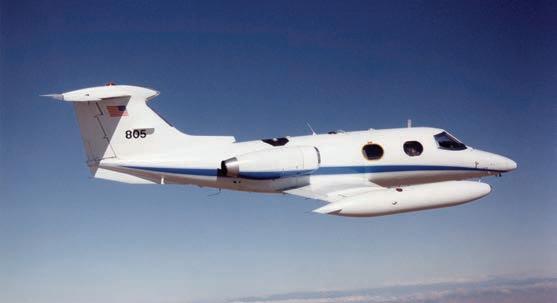
6 Airshare doubles down on Challenger order
8 Argus: ‘Di erent dynamics at play’ with dip in Q1 operations
10 Cessna SkyCourier wins Brazilian type certification

12 Geared Up: Portable deicer fills gap at small airports
14 Bringing Lear Jet 003 back to flight
32
38 The not-so-new vision of air taxis
Safety: Circling approach, is it your best option?

36 News from EAA AirVenture Oshkosh
40 Runway excursions: Does the hype about causes and types match with reality?
DEPARTMENTS
21 Expert Opinion | 46 Avionics | 48 Rotorcraft
50 On the Ground | 52 MRO | 54 Accidents
56 Compliance | 58 People in Aviation
On the cover: NASA's Super Guppy against the backdrop of the fireworks celebration at EAA AirVenture, Oshkosh, Wisconsin. Photo: Rob Olewinski.
Aviation International News \ September 2023 \ ainonline.com 2
In this issue
A220. GREATER VALUE IN CLEAN SHEET DESIGN
At Airbus, we’re committed to our journey towards decarbonisation. That’s why the A220 bene ts from a brand-new lighter design with innovative materials and ef cient aerodynamics. Enhanced to give airlines class-leading operating costs, optimal route pro tability, and a quieter cabin, together we can help to keep the world a beautiful place.

airbus.com
NTSB: Night close call blamed on Learjet flight crew
 BY GORDON GILBERT
BY GORDON GILBERT
Despite acknowledging ATC instructions to line up and wait (LUAW), the flight crew of a Learjet 60 took off without clearance at Boston Logan International Airport (KBOS) and thus caused a near-collision with a JetBlue Embraer E190, according to the NTSB final report published August 3.
The incident occurred at 6:55 p.m. on February 27. BOS tower told the crew of the Learjet, operating as a Part 91 positioning flight by charter operator HopA-Jet, to LUAW on Runway 09 while the JetBlue E190 was cleared to land on Runway 04R.
The Learjet crew read back ATC’s instructions to LUAW, but then began the takeoff roll. After being alerted by the airport’s surface-detection equipment, model X, the controller issued a go-around to the JetBlue crew, and they initiated the maneuver while over Runway 04R before reaching the intersection with Runway 09.
The closest proximity between the airplanes occurred when the E190 was about 30 feet agl during the landing flare, near the point where the runways intersected. As they entered the flare after crossing the threshold, the JetBlue pilots saw the Learjet cross 04R on Runway 09 but could not estimate how far away the airplane was.
The Learjet captain said they had heard a clearance that “seems to be line up and wait.” He added that “he probably responded to the clearance, but in his mind, they were cleared for takeoff.” After departing, ATC gave a phone number to call upon landing. In that call, BOS tower told them that they had taken off without authorization and caused an airplane that had been cleared to land on Runway 04 to execute a go-around, passing about 400 feet above them. Both pilots filed NASA ASRS reports after the phone call. z
News Briefs
WHEELS UP GETS LIFELINE
Aircraft membership and charter company Wheels Up on August 9 canceled its second-quarter financial results release and investor call scheduled for that day and instead announced an unspecified, shortterm cash infusion from Delta Air Lines, which owns 20 percent of Wheels Up. It also said it is pursuing “strategic options,” including the o oading of its aircraft management business, which Wheels Up termed a “non-core” asset, to business aircraft fractional, charter, management, and maintenance provider Airshare. The deal for Wheels Up’s aircraft management business is expected to close in the third quarter.
SUPPLY- CHAIN WOES WEIGH ON GULFSTREAM
Gulfstream Aerospace delivered 45 aircraft (35 large-cabin and 10 super-midsize G280s) in the first half, down from 47 (38 large-cabin and nine G280s) a year ago and will miss its 2023 delivery forecast of 145 by five or six units, Phebe Novakovic, chairman and CEO of parent company General Dynamics, said. The company expects to deliver 27 aircraft in the third quarter, meaning approximately 68 will be in the last quarter. Meanwhile, order intake for Gulfstreams remains robust, with a book-to-bill of more than 1.3:1 in the second quarter. Gulfstream’s backlog stood at $19.497 billion at the end of the quarter, about $700 million higher than a year ago.
DASSAULT SEES 1H SLOWDOWN
Dassault Aviation is maintaining its fullyear guidance and still expects to deliver 35 Falcon business jets and 15 Rafale fighters this year despite a weak first half due to supply-chain issues. The French OEM delivered nine Falcons in the first six months, down from 14 in the same period last year. Further, it registered net orders for just 12 Falcons, less than a third of the 41 it sold in first-half 2022.
Aviation International News \ September 2023 \ ainonline.com 4
This screenshot shows a portion of the freeze-frame image captured from a video taken by a jump seat pilot on a JetBlue Embraer E190 landing on Boston Logan International Airport’s Runway 4R on February 27. The ghostly image of the Hop-A-Jet Learjet is di cult to see as it takes o on the crossing runway (Runway 9) after its crew was instructed by ATC to line up and wait.
Elevating human performance. Advancing operational excellence.

CAE Civil Aviation is a global leader in the design, development, and delivery of the industry’s most advanced training and digital tools for optimizing day-to-day operations. Today, we are creating ever better, smarter, and more future-minded programs and solutions, elevating and advancing human performance across entire organizations, and ensuring superior outcomes and effciencies for business aviation operators and airlines the world over.
www.cae.com
CIVIL AVIATION
Airshare doubles down on Challenger orders
BY KERRY LYNCH
Lenexa, Kansas-based fractional ownership provider Airshare is ordering up to 20 Bombardier Challenger 3500s, potentially doubling its fleet of super-midsize Challengers. Airshare in May 2021 placed an order for up to 20 Challenger 350s, the predecessor to the 3500, moving into larger aircraft after building its fractional program around Embraer Phenom 300s.

That original Challenger order included three aircraft and 17 options, but Bombardier noted that Airshare is placing the follow-on order as it exercises all the options from the initial deal. The latest contract includes firm orders for four Challenger 3500s and options for 16 more. At list prices, the latest deal could be worth $544 million, if all options are exercised.
News Briefs
BOMBARDIER DELIVERIES TICK UP
Bombardier delivered 29 aircraft in the second quarter, one more than a year earlier, but the mix shifted to more Challengers (15 versus 12) and fewer Globals (14 versus 16). Even so, quarterly revenues climbed 8 percent, to $1.7 billion, while earnings rose 37 percent, to $275 million. In the first six months, Bombardier delivered 51 business jets, up from 49 a year ago, with Globals accounting for 28 of them. Bombardier president and CEO Éric Martel said the company is on track to meet guidance of 138 deliveries this year. Bookto-bill has remained at about 1:1 for the year, while backlog edged up to $14.9 billion.
TEXTRON POSTS STRONG 2Q DESPITE CHALLENGES
“The response we have received to the Challenger entering our fractional program has been tremendous, from both new and existing customers,” said Airshare president and CEO John Owen. “The strength of our partnership made it easy for us to accelerate our plans to order more of these aircraft to meet customer demand.”
In its by-the-day fractional-share program, Airshare offers 1/16th shares in the Challenger, which includes 20 days and unlimited flight time during those days up to a maximum of a 14-hour crew duty day. The Airshare program also provides a 25 percent discount on the hourly rate when shareowners begin and end flight days at the same location. z
In the second quarter, Textron Aviation reported a $78 million revenue improvement compared with a year earlier, to $1.4 billion, thanks to strong demand and beneficial pricing conditions, even while aircraft deliveries proved “light” due to supply-chain issues. Because of this, the company won’t meet its guidance for 200 deliveries this year. Textron Aviation’s production constraints led to a decrease in Citation deliveries from 48 in second-quarter 2022 to 44 this year, while the company saw a modest increase in turboprop deliveries from 35 to 37. Backlog grew by $315 million in the quarter.
EMBRAER AIRCRAFT DELIVERIES SOAR 47 PERCENT
Embraer deliveries jumped by 47 percent in the second quarter to 62, including 38 executive jets and 24 airliners. This compares with a total of 47 delivered in the second quarter of 2022, including 30 executive jets and 17 airliners. Phenom deliveries were up by six units, to 25, and Praetors rose by two, to 13. With the spike in deliveries, backlog ebbed slightly to $17.3 billion at the end of June. During the quarter, Embraer scored a NetJets order for up to 250 Praetor 500 jets.
Aviation International News \ September 2023 \ ainonline.com 6
Airshare is building on its fleet of Bombardier Challenger 350s with an order for up to 20 of the successor model, the Challenger 3500.
The response we have received to the Challenger entering our fractional program has been tremendous, from both new and existing customers...

© 2023 Garmin Ltd. or its subsidiaries. G5000® UPGRADE FOR CITATION EXCEL/XLS Breathe new life into your aircraft by adding available capabilities, such as georeferenced charts, datalink weather, TCAS II, ADS-B traffc, TOLD, CPDLC, SafeTaxi®, SurfaceWatch™ and more. Visit garmin.com/XLS or contact Dave Brown at 913.440.1714 or dave.brown@garmin.com UPDATED AVIONICS. UPDATED AWARENESS. UPDATED INTERFACE.
News Briefs
LOU PEPPER STEPS DOWN AS ATLANTIC AVIATION CEO

Argus: ‘Di erent dynamics at play’ with dip in Q1 ops
BY KERRY LYNCH
Business aircraft activity experienced a notable shift in the first half of the year with consistent declines in the Part 135 market, a jump in fractional operations, and a mostly flat Part 91 sector, Argus reported in its Mid-Year Business Aviation Review. Globally, business aviation flight activity ebbed by 2.6 percent during the first six months versus the first half of 2022.
“We are six months into 2023 and different dynamics are at play in the broader business aviation market, compared to the prior years,” the aviation safety and data specialist said. “We are no longer seeing the consistent growth on top of growth that was so prevalent in the postCovid days.”
The combined dynamics between the three operational sectors collectively resulted in a 3.7 percent year-over-year decline in first-half operations in North America. Argus cautioned that this drop is against a backdrop of record highs logged in 2022 and said activity remains strong, averaging at some 288,000 flights per month during the first half of the year,
compared with 260,000 during the same period in pre-pandemic 2019.
By segment, fractional flights in North America were up 6.9 percent year-overyear in the first half, while Part 135 operations dropped by 10 percent and Part 91 by 1.9 percent. Flights in the region were down in all aircraft categories led by midsize aircraft (-5.5 percent) and followed by light aircraft (-4.3 percent), turboprops (-3.2 percent), and then large-cabin jets (-1.1 percent).
Europe has seen a consistent decline— down 11.9 percent year-over-year in the first half—but Argus sees signs of stabilization. Going forward, Argus expects a leveling of between 5 percent and 10 percent year-over-year, a steadying from the postCovid highs.
Overall, Argus is projecting that activity will dip by 0.6 percent year-over-year in the back half of 2023. This will still be a 13.4 percent increase over the same period in 2019. Argus anticipates traffic to reflect normal activity with peaks in August and in October, slowing in the last two months of the year.
Lou Pepper, who led FBO chain Atlantic Aviation as its CEO for more than 30 years, has stepped back from this role. On August 14, Je Foland took over as CEO of the company, leaving Pepper to “fully focus on his role as a member of Atlantic Aviation’s board of directors.” Foland has nearly three decades of experience in the aviation, travel, and transportation industries. Under Pepper’s leadership, Atlantic Aviation grew from 16 FBOs into one of the biggest chains with more than 100 locations in the U.S. and Caribbean.
EPIC RAISING E1000 GX PRODUCTION
Epic Aircraft plans to deliver 20 E1000 GX turboprop singles this year and 24 of the $4.45 million all-composite aircraft next year, company marketing director Amy Trenz told AIN. The company is closing in on FAA certification for flight into known icing conditions, with all aircraft delivered in 2024 expected to have this approval, she added. Trenz said that “like everyone else,” the company has had to deal with supply chain issues, but that Epic has been successful in recruiting workforce and optimizing production. Epic delivered 10 aircraft in 2021 and 16 last year.
GULFSTREAM G550 FLEET ACHIEVES MILESTONE
Gulfstream’s G550 fleet recently achieved its one millionth flight. The long-range twinjet entered service in 2003 and served as the top of the Savannah, Georgia airframer’s line until certification of the G650 in 2012. While production of the G550 ceased in 2021, more than 600 remain in service. The G550 marked the debut of Gulfstream’s enhanced vision system—now known as enhanced flight vision system—which helped the company receive the 2003 Collier Trophy from the National Aeronautic Association.
Aviation International News \ September 2023 \ ainonline.com 8
z
Fractional-share flight operations increased in the first half of 2023, but all categories of aircraft saw fewer flights, Argus reported.
MARK WAGNER
ENHAN C EDTRAININ G

PR OVEN RE SULTS
For 10+ years, FlightSafety International (FSI) and Pratt & Whitney Canada (P&WC) have collaborated to develop, improve, and implement cutting-edge technology for aviation maintenance professionals around the world. Together, we are now introducing virtual engine training that provides real-time, interactive animation of the engine. This allows technicians to take their skills to new heights by exploring engines down to the component level. The result—enhanced engine-specific understanding and elite performance in the sky.

Prepare to lead with FSI.
+1 201.584.8262 | FlightSafety.com






News Briefs
AIRBUS HELICOPTERS H175 CERTIFIED IN CHINA
Cessna SkyCourier wins Brazilian type certification
BY GREGORY POLEK
The Cessna SkyCourier utility turboprop twin won type certification from Brazil’s ANAC, parent company Textron Aviation announced at LABACE 2023. The approval allows for its delivery and operation in the expansive Brazilian market for regional, utility, and special-mission aircraft.
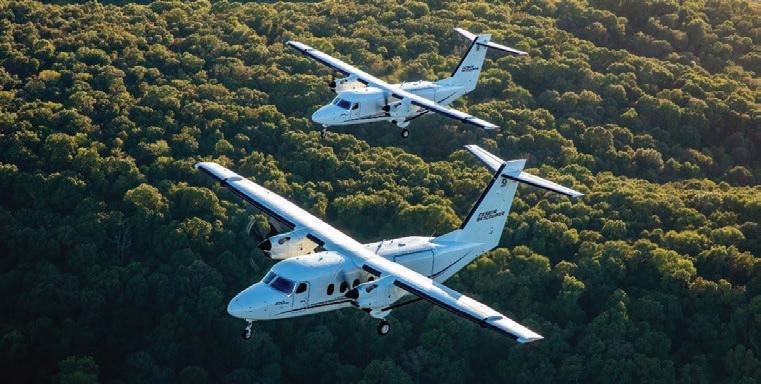
Calling the SkyCourier an ideal fit for Brazil’s diverse geography, remote locales, and growing demand for air transportation, Textron promotes the aircraft as “an unparalleled combination” of performance, capacity, and capability, positioning it as a catalyst for enhanced regional connectivity, efficient cargo transportation, and reliable regional passenger operations.
Featuring short takeoff and landing capability, the aircraft can operate from small runways, allowing it to reach remote communities and locations with limited infrastructure. Separately, the aircraft’s recently certified gravel kit option further expands the
SkyCourier’s capability to operate from unimproved runways.
Along with a freighter version, Textron offers the high-wing turboprop in a 19-passenger variant that includes separate crew and passenger entries for smooth boarding, as well as large cabin windows for natural light and views. Both configurations offer single-point pressure refueling.
Designing the SkyCourier to feature simple systems and easy access points for ease of maintenance, the aircraft’s development team also devised ways to convert the aircraft from a 19-seat passenger configuration to a cargo configuration using quick-release seats and removable bulkheads.
Powered by two wing-mounted Pratt & Whitney Canada PT6A-65SC turboprop engines, the SkyCourier flies to a maximum cruise speed of more than 200 ktas and a 900-nm maximum range. It features a large cargo door and Garmin G1000 NXi avionics, and the freighter variant can hold up to three LD3 shipping containers with 6,000 pounds of payload capability. z
The Airbus H175 super-medium-twin helicopter in late July received certification from the Civil Aviation Administration of China (CAAC), clearing the way for delivery of four of the aircraft in the country later this year. The H175 received its nod from EASA in 2014 and the current in-service fleet of 53 in 13 countries has amassed 185,000 flight hours on missions including o shore energy, search and rescue, public services, and private and business aviation. Last year, CAAC certified the AC352, a version of the H175 produced in China, but deliveries of new H175s into China suggest that the AC352 production line has not yet fully matured.
SEN. MARKEY WANTS HIGHER TAXES ON ‘ FAT CAT ’ JETS
Sen. Edward Markey (D-Massachusetts) is taking aim at “fat cat” corporate aircraft with a bill to increase fuel taxes for private jets ninefold from the current 21.9 cents per gallon to $1.95. Entitling the bill the Fueling Alternative Transportation with a Carbon Aviation Tax—or FATCAT—Act, Markey estimated that the tax increase would be the equivalent of charging about $200 per tonne of a private jet’s CO2 emissions. Resulting tax revenue would help fund a newly created Clean Communities Trust Fund. The path forward for such a bill is unclear, particularly in the House.
PT6 HITS 500M FLIGHT HOURS
Pratt & Whitney Canada is celebrating the 60th anniversary of its ubiquitous line of PT6 turboprop engines, of which more than 61,000 have been delivered and installed on 42,000 aircraft, with a combined fleet time of 500 million hours. The company also is marking the one billionth flight hour of all its engines since 1928. The latest iteration, the E series, has a 5,000-hour TBO interval and requires 40 percent less maintenance.
Aviation International News \ September 2023 \ ainonline.com 10
The Cessna SkyCourier can now be sold in Brazil following type approval from ANAC.
LABACE 2023





Geared Up
Portable deicer fills gap at small airports
BY JAMES CARELESS
When it comes to flying safely, deicing is as important to small aircraft at remote airports as 737s at big ones. However, the economics associated with conventional deicing systems can make them too expensive for many small airports to install.
To fill this gap, Wing Armor of SaintColomban, Quebec, has developed the Jetstream towable deicing system. It is small enough “to be loaded into the baggage door of a de Havilland Dash 8 aircraft, so it may be flown to remote airports that have limited road access,” said Walter Randa, Wing Armor’s founder and CEO. Yet the Jetstream has enough fluid capacity and delivery power to fully deice personal and business aircraft, he told AIN, and even clear off frost and light snow off a 737.
The Jetstream deicer unit can hold up to 150 gallons of deicing fluid. Its onboard 400,000-BTU heater and element can keep that fluid “at a pre-heat temperature of 40-deg Celsius [90 deg F] so the fluid can be rapidly brought to 80 deg Celsius,” said Randa. The Jetstream sprays three to four gallons of deicing fluid per minute via a 38-inch spray gun with a variety of settings. This is connected to a reeled 100-foot-long reinforced hose mounted on the Jetstream towable unit.
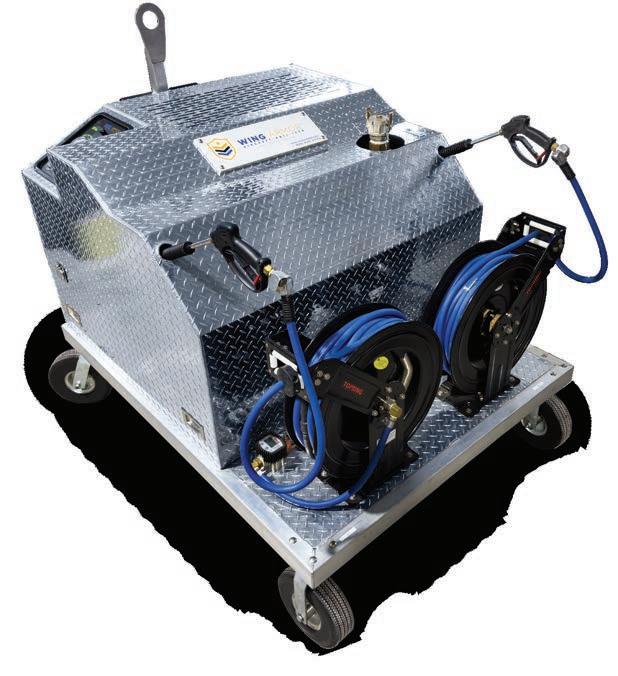
The deicing spray system is powered by a gas-fueled Honda generator, while the 400,000-BTU heater consumes diesel fuel. “Since it sprays only three to four GPM, it is ecologically safe, and yet provides a powerful spray to melt most types of contamination found on fixed-wing and rotorcraft aircraft,” Randa said. The Jetstream also has an onboard digital meter that precisely measures the amount of deicing fluid consumed.
With its ability to be moved to any airport that a Dash 8 flies into, the Jetstream deicing unit can be deployed at remote airports and gravel airstrips—anywhere that has a hangar and a tractor capable of towing the unit onto the tarmac. “What you would expect from a big deicing truck, you can get from this small unit,” said Randa. “With its low-pressure spray, it can be used safely on small aircraft and helicopter rotors.” Wing Armor provides onsite training programs to bring ground crew up to speed on how to operate the system safely.
Manufacturing of the Jetstream deicer is done at Wing Armor’s new plant in Vankleek Hill, Ontario. This is just west of the Ontario/Quebec border, and close to the 401 highway that links the plant to Montreal and Toronto—including a number of airports capable of handling Dash 8 aircraft.
“We’re looking to promote the Jetstream to all the people out there who are looking for a very affordable option to deice smallor medium-sized aircraft and helicopters,” Randa said.
In addition to its Jetstream towable deicing unit, Wing Armor also sells in-hangar anti-icing treatment systems. This towable
Wing Armor’s Jetstream portable deicer is small enough to be flown to remote airports in a Dash 8 but capable of deicing smallto medium-sized aircraft and removing frost and light snow from a 737.
cart uses an Eagle air compressor to spray up to 60 gallons of anti-icing fluid at a time, via two spray guns on 75-foot hose reels, allowing both wings to be anti-iced simultaneously. It has two Turbo XL digital meters that will accurately measure the amount of anti- icing fluid sprayed from each gun, while four 10-inch tubeless tires make it easy to maneuver the cart by hand, even with a full tank of fluid.
The fact that the Wing Armor tank comes with a wide two-inch filler neck makes it quick to refill, while a built-in brass ball valve ensures operator safety whenever the tank’s cap has to be removed for refilling. z
12 Aviation International News \ September 2023 \ ainonline.com
A Fuel Brand Built on 5 Decades of Dedication

Avfuel leverages 50 years of aviation expertise to support a global fueling network of 3,500+ locations and 675+ Avfuel-branded FBOs. This means greater connectivity and service options for FBOs and flight departments alike.
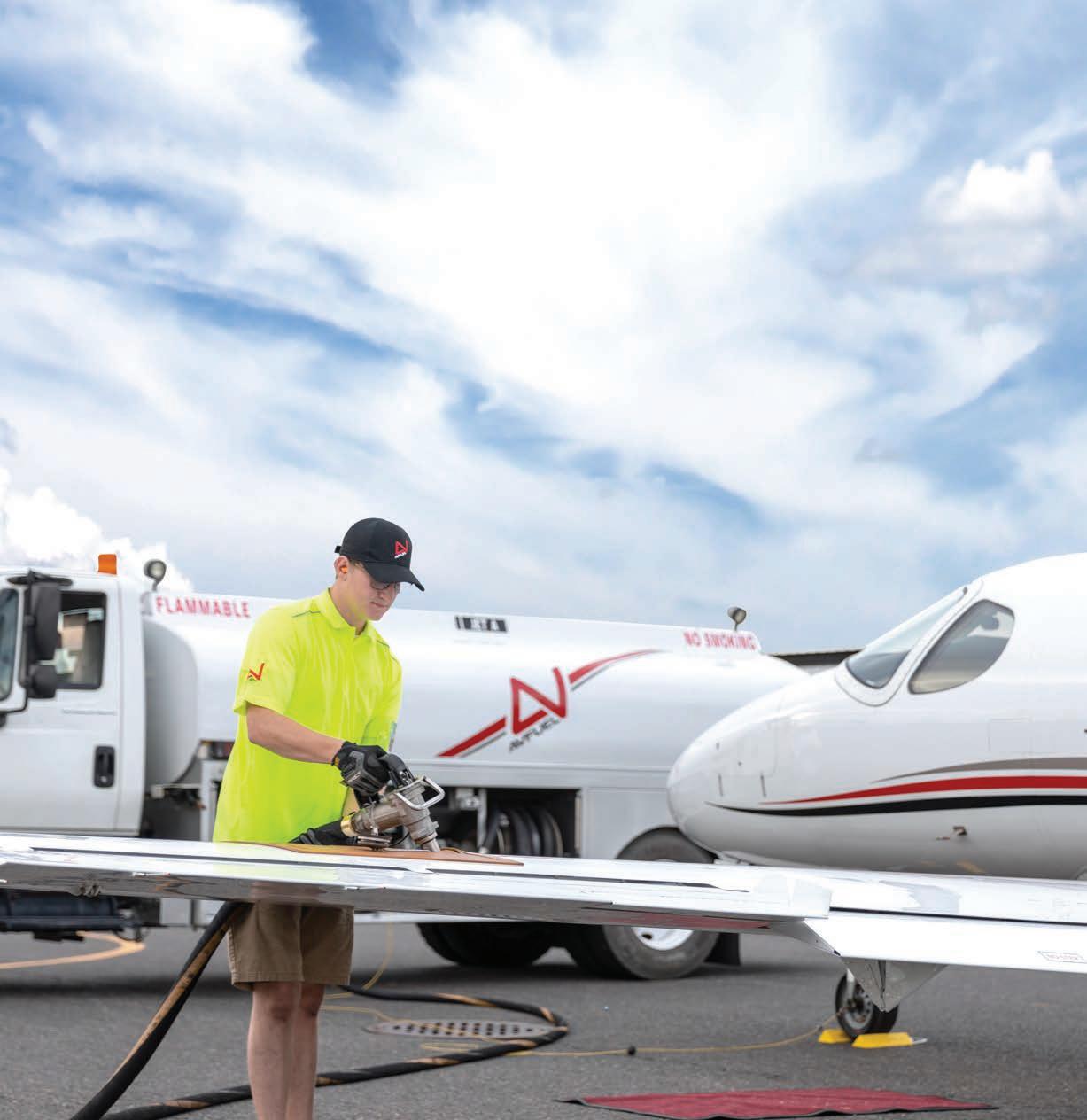
Global Fuel Supply Sustainability Programs FBO Branding
Bringing Lear 003 back to flight
BY CURT EPSTEIN
It can certainly be argued that the Learjet is the progenitor of today’s multi-billiondollar business aviation industry. When the first of the sleek, speedy Lear 23s was delivered in 1964, it immediately gained acceptance from celebrities and captains of industry alike and established a market for private jet aviation, elevating the name Lear Jet into the public lexicon as an icon of new travel freedom and privilege.

Lear 23-003—the first of the type to be delivered—has now found its way back to its Wichita birthplace, where an ambitious program to return it to flight status has begun. At the same time, it is in the process of being acquired by the Classic Learjet Foundation (CLF), a non-profit organization founded by former and current industry employees with the goal of restoring 003 to its 1964 condition.
Richard Kovich, the group’s historian, had been following the aircraft’s journey, given its archetypical status. “About 2018, I was notified that it was no longer registered,” he told AIN. “So that kind of got my curiosity
up to find out where the airplane was and what was going to happen to it.”
Kovich’s search ended in February 2022 when he received a phone call from the father of the aircraft’s owner asking if he knew someone who wanted to buy the airplane. In July 2022, what would eventually become the CLF’s leadership traveled to Florida to examine the condition of the aircraft, which had been stored outdoors for more than a decade at Tampa-area Bartow Executive Airport.
A few months later, it would suffer rudder damage from last year’s category 5 Hurricane Ian. But during its idle years, it had been tightly buttoned up and had not acquired any animal stowaways. Later, once the tires were pumped up and it was rolled into a hangar, Lear 23-003 was powered up and the cockpit lights came on.
“The airplane is complete, instrument panel, clock, everything is there,” said Kovich. “We didn’t try to motor the engines, because they had been sitting outside for 10 to 12 years. But we came to the
conclusion the airplane was worth it.”
A brief examination of the records showed it had last flown more than two decades ago. “The last maintenance event was in 1998. There was another logbook entry in 1999 and the time didn’t change— it had just under 5,900 hours on it at that time—so we believe they flew it until the landing gear and engines cycled out, and then they parked it,” said Bill Kinkaid, the organization’s president.
AND THE PRICE IS...
After lengthy negotiations, the two sides agreed on a purchase price of $90,000, down from the owner’s initial asking price of $250,000. “We were dealing with the actual owner. We leveled with him, and we said there is no way anybody is going to pay a quarter of a million bucks for this airplane,” Kinkaid told AIN , adding the owners knew of the airplane’s significance and that someone would eventually come looking for it. “They had time equity in the airplane—they saved it and somewhat
Aviation International News \ September 2023 \ ainonline.com 14
After years stored on a ramp at Bartow Executive Airport, Lear 23-003 was rescued by the Classic Learjet Foundation.
For 11,500 Part 91 operators, CAA membership means more savings, more freedom, and more control. We negotiate the best jet fuel prices from more than 275 preferred FBOs throughout the US and beyond. You even get to vote on which FBOs we include — and recommend your favorites.


30% ON AVERAGE.
JOIN FOR FREE TODAY! Scan here or visit www.caa.org CAA provides the lowest price on jet fuel o ered to Part 91 aircraft at the CAA Preferred FBO.
Everywhere You Roam. Including Rome. SAVE
TRY IT FOR 3 MONTHS FREE.
stored it somewhere around 25 years—so they deserved to be compensated for their effort.”
In the end, the owner concurred with the group that the airplane should be preserved. “I think we were pretty good at convincing them that we’re probably about their best bet in the world really,” continued Kinkaid. “We’re all passionate, we’re all enthusiasts, we have the connections, and we have the technical expertise to raise the money and get the airplane in the air again, so we came to a pretty good agreement there that I don’t think he would have found with another buyer.”
Indeed, given the aircraft’s pedigree and intrinsic historical value, some might think that it could have found a home at the Smithsonian’s National Air and Space Museum in Washington, D.C. But that institution already has the only older Learjet on display: 002, which was used in the flight test program and was acquired directly from the manufacturer (001 was lost in a non-fatal flight test accident back in 1964).
Once the price for 003 was settled, the foundation gave the owner a down payment, which resulted in the release of the GE CJ610-1 engines and the engine maintenance records. These were sent directly to International Turbine Industries in Michigan for refurbishment. International Turbine will convert them to CJ610-4 standard as an in-kind donation.
One of the treasures of the acquisition is 23-003’s complete set of logbooks, dating back to its delivery, making them somewhat of a time capsule. “Lyman Yandell was the chief inspector for Learjet in the very early days, and his name is in the logbook,” said Kinkaid. “He’s the one that declared it to be airworthy back in 1964.”
The airframe itself was disassembled for transport to Wichita, the self-proclaimed “Air Capital of the World,” where it was built nearly six decades ago and where the foundation—which was officially founded last September—is based.
CROSS-COUNTRY
The wing was removed, and the fuselage was loaded onto a special cradle. Both arrived in Kansas via a flatbed truck in late February. Bombardier, which acquired Learjet in 1990, donated space to house the aircraft in Building 14 at its complex, the same building where Learjet deliveries formerly took place.

While the exterior and cabin of 003 were observed, thus far the foundation has not yet had the opportunity to thoroughly examine the airframe structure. “We are under a sales agreement with the current owner of the airplane, and when we get him paid off is when we can actually start the restoration process,” explained foundation v-p Joel Weber.
The foundation still needs to raise approximately $50,000, according to Chris Marshall, the group’s secretary and head of fundraising. While it has applied for grants that could help bridge that gap, it is still seeking financial donations.
Much of the restoration work will be performed by industry volunteers, and the foundation expects there to be many from the city’s current and retired aviation workforce—some of whom even worked on the Lear 23 assembly line in the early days—but how long the project could take to complete remains to be determined.
“If we were dealing with a 23 that was in service and came in, we’d be talking about six to eight months, but this isn’t that airplane,” said Kinkaid. “We know the wing could be a basket case, and until we get it x-rayed and get into it and cleaned up, we honestly don’t know.”
Depending on how smoothly the process goes, estimates for completion range between three and five years.
In terms of other parts that may be required, the foundation has tracked down several Lear 23 carcasses in two wellknown aircraft salvage yards. “I’ve been through a lot of the old fuselages sitting around, and I know there are a lot of useable parts that we will probably get,” said Weber. “Both owners of those companies already gave me a verbal commitment that whatever we want, we can have.”
The aircraft’s interior had been replaced at least once during its life, and the group’s intention is to return it to factory-stock standard. “We want to go back to original,” said Kinkaid. “One of the other things we have is access to a lot of the archival information both from a technical standpoint but also from a marketing and sales standpoint, so we have access to a wonderful treasure trove of data that will help us restore the airplane.”
As well, he added that local service providers have stepped up. “We’ve had some very early commitments to in-kind donations of services to be provided for us,” he said. “It’s not like we really even had to ask. As soon as they knew this was going to happen, they said, ‘We want to do the interior.’ That is one of the ways in which we think the restoration can succeed and move quickly, because so many people are interested in participating.”
The group is pursuing similar offers for the aircraft’s windows and exterior paint.
Aviation International News \ September 2023 \ ainonline.com 16
On Oct. 13, 1964, Learjet 23-003 became the first Learjet delivered to a customer.
While the cockpit is complete, the CLF acknowledges some changes will have to be made. “I think that the desire of the foundation is that we leave it as original as possible, but looking at a safety factor and some operational limitations that we may be faced with would force us to do some updates,” said Weber.
SEEKING EXEMPTIONS
Likewise, a decision will have to be made as to whether to bring the aircraft into compliance with current noise regulations. “We have a compliance path, which would mean a hush kit, and we also have an FAA exemption path through living flight history programs,” explained Kinkaid. “We can’t actually start any of the exemption paperwork until the airplane is in the foundation’s name.”
One hurdle already cleared is securing 003’s original N-number, N200Y. During
its long life, the aircraft had changed registration, and the number it wore on delivery had since passed along to a Cessna Sovereign owned by a Louisiana-based corporation. “Through months of pestering them and begging them, I got them to agree to release that N-number to us, and it was at a convenient time because this year they are going to repaint the airplane anyway,” Weber told AIN. In return, the foundation had to wheel and deal to secure a personalized replacement registration number that satisfied the company owner. Just in case that effort failed, the foundation also obtained the tail number 003 wore during its flight test program.
Since there are no other operating Lear 23s left, the group expects to bring 003 to airshows such as EAA AirVenture and Sun ‘N Fun, Marshall said, “[so] people can see what the first purpose-designed, purpose-built business jet looked like, sounded like, and to see it flying.”
SMART
EVERYTHING-ALL-AT-ONCE INFLIGHT WI-FI
Through the airplane, the foundation wants to not only tell the story of Bill Lear and the people who developed the aircraft that became synonymous with private luxury travel in the ’60s and ’70s, but the roles that entrepreneurship and technical development played as well. “The marketing and celebrity endorsements, these are relevant in today’s economy,” said Marshall. “We want to bring elements of that story and use them in schools to educate kids to inspire them to pursue careers in technology and careers in aviation from grade school on up to college.”
The foundation also pictures 003 as a symbol of Wichita’s proud aviation history. “This airplane we believe set the pace for all of the business jets that have been delivered out of Wichita,” said Weber. “We don’t want to make it just about the Learjet legacy, we want to make sure we publicize that and make sure that the whole town owns this, and the whole business jet world owns this.” z
Most inflight connectivity services limit what you can do and how many devices can connect at the same time. Not SmartSky. Our high-capacity two-way data flow keeps you continuously connected to what’s most important on all the devices you and others on the plane need – including the cabin, cockpit and operations. Make the SMART choice for the best WiFi in the sky. All the others are just so so.
Ask for SmartSky on your jet. 800.660.9982 or info@smartskynetworks.com smartskynetworks.com

ainonline.com \ September 2023 \ Aviation International News 17
SmartSky_AIN_half_pg_ads_2023.indd 7 8/7/23 10:20 AM
*Limited time offer. Terms and conditions apply.
Legacy Tails
Lear Jet 23—The birth of a legend
BY DAVID DONALD
There are only a handful of airplane types whose names have made it into the lexicon of the public at large: Blackbird, Concorde, B-52, and 747 Jumbo Jet, to name a few. To that list must be added the name Lear Jet (or Learjet as it later became), which rapidly became a synonym for the private jets that transported the rich and famous between their glamorous engagements and vacation retreats.
While the marque may no longer be in production, and its status as a must-have accessory for celebrities and industry luminaries long usurped by names such as Gulfstream and Falcon, its legacy will live on for decades.
It had an unlikely beginning. The renowned engineer and inventor William “Bill” Powell Lear Sr. had been flying since the early 1930s and had turned his fertile brain to developing electronic navigation
aids. Among his credits was the world’s first automatic landing system. He also dabbled in aircraft design, creating the Learstar, an executive conversion of the World War 2-era Lockheed Lodestar that was modified in the 1950s by PacAero in Santa Monica, California.
This early experience in business aviation fired Lear to create a purpose-built private/ corporate jet to capitalize on what he saw as a burgeoning demand for such an aircraft, despite the relatively slow early sales of the first generation of business jets. However, the desire to build aircraft was at odds with the board of his company, Lear Incorporated, which was eventually sold to Siegler in 1962.
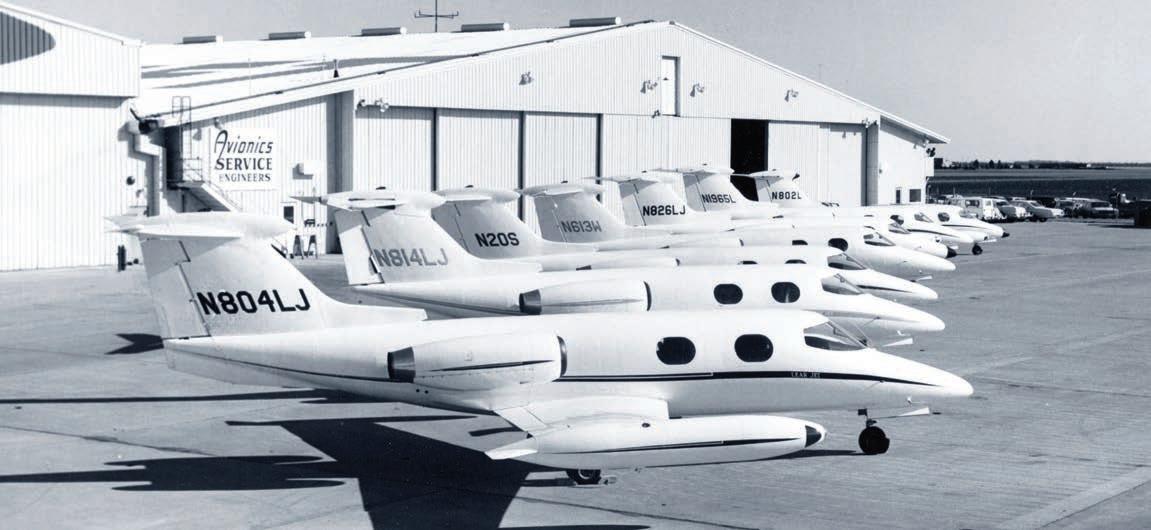
In the meantime, Lear had moved to Switzerland in 1960 and founded the Swiss American Aviation Company (SAAC). Its aim was to create a private jet based on the P-16 fighter. Designed by Flug- und
Fahrzeugwerke Altenrhein (FFA), the P-16 was a straight-winged fighter bomber intended for the Swiss air force powered by a single Armstrong Siddeley Sapphire turbojet. Five were built, of which two crashed, and the program was officially canceled in 1959 when the Swiss bought the Hawker Hunter. Although, FFA continued development for a year or so longer.
Lear saw considerable promise in the design as a basis for his jet, and SAAC employed a number of FFA engineers after the P-16 was finally mothballed. Despite some assertions to the contrary and despite some obvious similarities between the P-16 and Lear Jet such as the straight wing and wingtip tanks, there was very little crossover between the two designs in reality.
Design of what was initially known as the SAAC-23 Execujet was mostly undertaken at Althenrhein in Switzerland, with P-16
Aviation International News \ September 2023 \ ainonline.com 18
Some of the first Model 23s from the line pose at Wichita. At the far end of the row is the second prototype.
chief designer Hanz-Luzius Studer—who later designed the HFB 320 Hansa Jet with its trademark forward-swept wings—heading the team of British, German, and Swiss engineers. Lear planned to build at least the first three aircraft at Altenrhein, but instead moved the operation back to the U.S. for construction and final design, citing the slow speed of progress in Switzerland. A factory and design office was established in Wichita, Kansas, the company was renamed Lear Jet Corporation, and the new aircraft became the Lear Jet (later Learjet) Model 23.
In February 1962 construction of the prototype began, and on Oct. 7, 1963, Hank Beaird and Bob Hagen took it aloft for its first flight. Flight trials proceeded relatively smoothly until June 4, 1964, when the aircraft was lost in a crash. The pilot had inadvertently deployed the spoilers while demonstrating an engine failure after the takeoff event.
A second prototype completed the trials and is now on display in the UdvarHazy Center of the National Air & Space Museum. Despite the setback of the crash, which was attributed to pilot error, the FAA awarded the aircraft its type certification on July 31, 1964, and the first production aircraft was delivered on October 13.
ROCKETSHIP
From his days of turning a lumbering World War II transport into a sleek executive transport, Lear understood the importance of “ramp appeal,” and the Model 23 emerged as a sleek, futuristic design that oozed speed and glamour. Its rakish nose line and divided windscreen screamed “fighter,” an image further underlined by the stubby wings, tip tanks, and T-tail, all of which were redolent of what was then the Air Force’s hottest ship—the Mach 2 F-104 Starfighter.
The large, oval windows—one to port and two to starboard—hinted at opulence. That opulence did not extend to the cabin, however, which at just over four feet in both width and height made for relatively cramped accommodation. “You can’t stand up in a Cadillac!” was Lear’s alleged retort to such criticism.
Typically seating six passengers, although able to accommodate eight at a squeeze, the Lear Jet 23 had an mtow of 12,500 pounds—the FAA limit for small aircraft. It was pushed along by a pair of General Electric’s CJ610-4 turbojets, which each generated 2,850 pounds of thrust. This engine, which also powered the Hansa Jet and the Jet Commander business jets, was a civilian derivative of the J85, two of which were installed in the Northrop F-5 supersonic fighter.
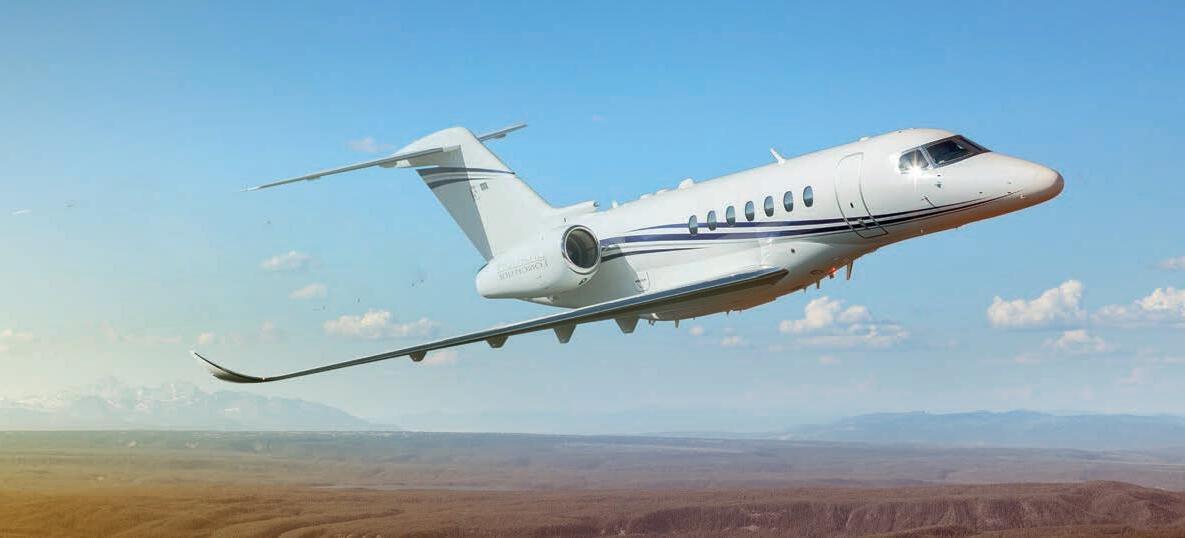
Offering a high power-to-weight ratio, the CJ610 combined with the Model 23’s sleek
INERTIAL SYSTEMS ENSURING MISSION SAFETY AND PERFORMANCE

ainonline.com \ September 2023 \ Aviation International News 19
With light weight, small volume, outstanding environmental robustness and unmatched performance, LITEF’s LCR Family of Inertial Systems delivers value to the operators of all types of civil and military aircraft.
LCR-350B
LCR-110
LCR-100
Legacy Tails
design and short wings to confer scintillating performance on the private jet, at least when compared with aircraft of the day. Limiting Mach was 0.82, equating to a top speed of 561 mph at 24,000 feet. The Lear Jet 23 could reach 45,000 feet, offering a creditable rate of climb of 6,900 fpm. High-speed cruise was 518 mph at 40,000 feet, while at a more economical speed, the type could cover 1,590 nm at 485 mph while flying at 40,000 feet. And the Lear Jet 23 was aerobatic.
PRODUCTION AND CAREER
With such performance and looks, the Model 23 was an instant success among rich individuals and corporate owners alike. Perhaps the highest-profile customer was Frank Sinatra, whose aircraft was famously used by Elvis Presley and Priscilla Beaulieu to fly from Palm Springs to marry in Las Vegas on May 1, 1967.

The Model 23 was priced at around $650,000 fully equipped, considerably less than its rivals, helping its impressive sales record. However, the type was marred by a spate of accidents in the first three years of operation. This, in part, was attributable to the airplane being rather too hot to handle for a number of pilots that were unaccustomed to its levels of performance.
Lear Jet built just over 100 Model 23s at Wichita before the improved Model 24 was introduced. The final Model 23 left the factory in 1964 after less than two years of production.
Model 23s continued to make the news and gossip columns, though, and remained a firm favorite among their owners. Long-time Learjet advocate Clay Lacy used a Model 23 to film most of the aerial sequences for the 1986 “Top Gun” movie and subsequently flew the type in aerial displays for many years. NASA employed the type for chase-plane and trials duties at Edwards AFB, California.
As a footnote, the wings of a Model 23— minus tip tanks—were mated to a hybrid
Mustang fuselage to create the P-51R unlimited racer “Miss Ashley II.” The Griffon-powered monster first flew in 1997 but was lost in a fatal crash at the Reno air races in 1999.
By the late 1990s, the type’s numbers were dwindling, with fewer than 40 operational by the end of the century. On the last day of 2015, Stage 3 noise compliance regulations came into effect, grounding any Model 23s that had not been re-engined or fitted with hush kits. Today it is unlikely that any are still flying, although at least eight are on display in museums.
MODEL 23’S LEGACY
Even with the initial success of the Model 23, Lear Jet was already working on improvements. At first, the company sought to improve the basic Model 23 to take advantage of the 13,500-pound mtow permitted by FAR Part 25 regulations. The result was the Learjet 24, the first business jet to be certified under Part 25. As well as the mtow increase, the Model 24 had various improvements, such as increased cabin pressurization and engine fire extinguishers.
Lear Jet flew the first Model 24 on Jan. 24, 1966, and in May one was flown around the world in an elapsed time of 50 hours 20 minutes. Certification was received
on November 9. The Learjet 24 looked externally similar to the Model 23, and the first 81 24As were essentially similar barring some modifications. The following 24B introduced uprated CJ610-6 engines. The final models, the 24E and F, had cambered wings and other aerodynamic improvements, as well as 2,950pound thrust CJ610-8A engines. In 1977 the FAA-certified service ceiling was raised to 51,000 feet, the 24E/F becoming the first business aircraft to achieve what remains today as the benchmark in the sector.
In all, 259 Model 24s were built, but a more important derivative took to the air on Aug. 12, 1966, in the form of the Model 25. Some four feet, two inches longer than the 23/24, the Learjet 25 could seat eight in comfort. Production amounted to 369 and it was this type—perhaps more than any other—that cemented the Learjet’s place in the market.
A change to Garrett TFE731 power heralded the arrival of the slightly stretched Model 35, and its Model 36 long-range derivative, in 1973. Together they became the most popular of the Learjets, with 738 built before production ended in 1994, including more than 50 C-21As for the U.S. Air Force.
Aviation International News \ September 2023 \ ainonline.com 20
continues on page 60
Although it shares some elements with the Lear Jet, the FFA P-16’s straight wings and tip tanks were the only major design features that Bill Lear adopted for his business jet.
Training contract ethics and accountability
I’ve never been a fan of pilot training contracts—a legal document that binds a pilot to a flight department for a set period after earning a type rating or the pilot owes the employer for some portion of the training investment. I’ve always thought of these agreements as a red flag, and I know I am not alone. To many, it suggests a lowpaying job or a toxic work culture.
But given the high cost of type ratings and the difficulty to obtain them today, I’ve been thinking about the pros and cons of contracts for initial pilot training and also about the moral obligation that a highcost investment in training requires of both parties.
In business aviation, it’s not uncommon for a skilled pilot to join a flight department and have his/her initial type rating paid for by their employer. It’s also common for an existing pilot to receive a type rating when their company purchases a new aircraft.

However, a type-rating will increase the pilot’s competitiveness and earning potential. Once hiring managers find out, they’ll be calling. So, employers need to offer commensurate compensation, a level of life balance, and a healthy work culture.
The assumption is that the pilot will be a long-term employee, amortizing the training cost over time. But the current pilot shortage has challenged that. And many operators have seen their investment walk out the door for myriad reasons.
So, I am starting to hear more about the resurgence of training contracts to protect the employer. If some sort of agreement is indeed needed, what stipulations should go into a pilot’s offer letter? Is it okay to obligate them to stay for two years, or just one?
It’s a case of give and take. An agreement should be written fairly to protect both sides. An employer should guarantee fair
BY SHERYL BARDEN PRESIDENT AND CEO AVIATION PERSONNEL INTERNATIONAL

compensation and provide expectations for a positive workplace culture. A training agreement that says, “If you leave, you have to pay back part of the training,” is a negative way to enforce retention.
However, making a decision to leave after a significant investment raises moral and ethical questions. If an employer keeps their word and o ff ers a fair schedule and wage increase, it seems fair that the pilot should repay that employer at some level— preferably through service.
A person I know of who left his employer for that “job of a lifetime” negotiated a sign-on bonus with his new employer so he could repay his former employer—not because he had to, but because he felt a moral obligation to do so. z
ainonline.com \ September 2023 \ Aviation International News 21 LESS FUEL. LOWER ITT. MORE SAVINGS. Learn about Cessna STCs EPIC PERFORMANCE PACKAGE ADDS CAPABILITIES: Ofering increased climb and cruise speeds with enhance pilot control and handling.
Expert Opinion
The opinions expressed in this column are those of the author and not necessarily endorsed by AIN Media Group.
AIN Product Support Survey - Avionics
AIN readers rate avionics, cabin management, and airborne connectivity manufacturers

Garmin took top billing in this year’s AIN Product Support Survey for avionics makers, capturing the highest rating for flight deck avionics makers. Winning the category by a comfortable margin last year, Garmin posted an average overall score of 8.7 this year that was well ahead of the second-place finisher, Collins Aerospace, but still two-tenths of a point behind last year.
Gulfstream and Textron Aviation, meanwhile, which tied for top honors in the business jet category of AIN ’s Product
BY GREGORY POLEK
Support Survey for airframers, similarly tied in the cabin management system support category in this edition of of the survey, each with an overall rating of 8.1.
And, Satcom Direct’s 8.6 rating in airborne connectivity support placed it ahead of that pack.
While feedback from OEMs for last month’s airframer survey showed that virtually every company continued to feel the results of supply chain disruptions for a variety of parts, avionics
respondents generally appeared more circumspect in their responses.
Lufthansa Technik reported difficulties securing semiconductors, in particular, while others worked hard to address labor shortages; Honeywell, for example, added 1,000 employees over the past year to its repair and overhaul organization while dedicating some 150 managers to work on securing workers and a steadier flow of raw materials among suppliers.
Aviation International News \ September 2023 \ ainonline.com 22
Garmin
SURVEY RULES AND METHODOLOGY
AIN ’s annual Product Support Survey aims to quantify and rate through statistical analysis the product support functions of business aviation manufacturers over the past year. The survey, whose respondents include operators of business jets, pressurized turboprops, and turbine-powered helicopters, endeavors to encourage continuous improvement in airframe, engine, and avionics product support throughout the industry.
SURVEY TOOL
For the third year, AIN conducted the survey via a questionnaire developed in partnership with Rolland Vincent Associates, a Texas-based consultancy focused on aviation market research, strategy, and forecasting. Designed to provide improved ease of use and to encourage more participants to complete the entire questionnaire, the survey tool included Spanish and Portuguese versions along with clearer language and imagery around the categories and evaluation scale. Finally, it asked respondents to evaluate one full aircraft at
a time, including airframe, engines, and avionics.
METHODOLOGY
AIN emailed qualified readers a link to the password-protected survey website active from late April to mid-June. It asked respondents to rate individual aircraft and provide the tail number, aircraft age, and primary region of service. The survey also asked respondents to rate, on a scale from 1 to 10, the quality of service they received during the previous 12 months in the following avionics categories: Cost Per Hour Program; Parts Availability; Cost of Parts; AOG Response; Warranty Fulfillment; Technical Manuals; Technical Reps; and Overall Avionics Reliability.
THE RESULTS
In total, 593 unique respondents, representing 1,821 aircraft, from 57 countries completed the survey. While slightly above last year’s total, AIN did not receive enough responses to verifiably report on Collins Aerospace in airborne connectivity and Lufthansa Technik in cabin management systems. Rolland Vincent Associates
reviewed the data to ensure accurate and valid responses. It also compiled the final survey results in close coordination with AIN
RESULTS ANALYSIS
AIN’s analysis of the survey showed that scores slightly improved this year despite several challenges faced by product support organizations:
» Flight hours remained elevated between the May 2022 to May 2023 survey period and flying exceeded pre-pandemic levels in all business aviation segments. More flying leads to more unscheduled maintenance and demand on support teams.
» Supply chain disruptions created longer lead times for parts acquisition and have shown little sign of easing.
COMING NEXT
AIN has published its 2023 Product Support Survey results for avionics, cabin electronics, and airborne connectivity in this issue; next month will feature engine manufacturers, the final report in this series for 2023.
ainonline.com \ September 2023 \ Aviation International News 23 Category & Overall Average Ratings for Avionics Systems Overall Average 2023 Overall Average 2022 Rating Change from 2022 to 2023 Cost per Hour Programs Parts Availability Cost of Parts AOG Response Warranty Fulfillment Technical Manuals Technical Reps Overall Avionics Reliability Flight Deck Avionics Garmin 8.7 8.9 (0.2) 8.9 8.8 7.8 8.6 8.8 8.9 8.7 9.2 Collins Aerospace 8.1 8.2 (0.1) 8.1 7.8 6.6 8.0 8.6 8.1 8.3 8.7 Honeywell 7.7 7.6 0.1 7.7 7.5 6.4 7.5 8.4 8.2 7.5 8.4 Cabin Management Systems Gulfstream Cabin Management 8.1 8.0 0.1 7.5 7.6 6.6 8.7 9.2 8.2 9.1 8.0 Textron Aviation Cabin Management 8.1 7.9 0.2 8.0 7.4 7.2 8.7 8.7 8.3 8.9 7.9 Collins Aerospace 8.0 7.5 0.5 8.1 7.7 6.6 8.1 8.9 8.2 8.2 8.2 Honeywell 6.9 7.0 (0.1) 6.9 6.2 6.0 6.4 7.3 7.4 7.3 7.8 Airborne Connectivity Satcom Direct 8.6 8.4 0.2 7.6 8.4 7.4 9.0 9.1 8.7 9.5 8.7 Gogo Business Aviation 8.3 8.2 0.1 7.4 8.4 7.4 8.8 8.9 8.1 8.9 8.3 Honeywell 7.9 7.9 (0.0) 7.4 7.9 7.1 8.2 7.6 7.9 8.4 8.3
Taking the top score in every measurement of the flight deck avionics category resulted in Garmin’s six-tenths of a point lead over the next highest scorer, Collins Aerospace. Gamin’s highlights included overall reliability (9.2) and cost per hour programs and technical manuals (8.9 apiece). Even its weakest score, namely in parts cost (7.8), placed it at the top of all the OEMs for flight deck avionics.
THE IMPROVEMENTS:
Garmin’s customer support organization over the past year launched a four-year, $200 million expansion of its U.S. headquarters, including a relocation to new offices within the Garmin campus in Olathe, Kansas.
The project also included new manufacturing capacity, warehousing, and distribution, as well as a new Aviation Business Center housing meeting spaces and training facilities.
Other initiatives included the launch of the Garmin Aviation Dealer Academy, which provides new avionics training opportunities for installation technicians and avionics managers.
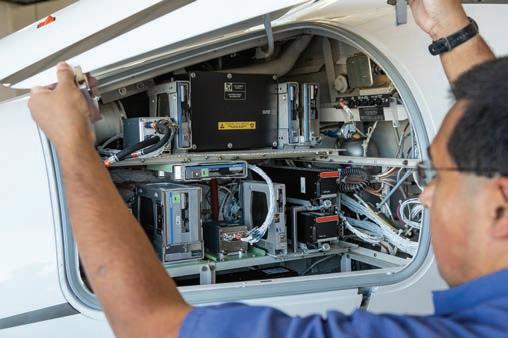
Garmin also reorganized its dealer support teams to provide regional-based technical support, improving response times and enhancing relationships with installation technicians.

Improvements to Garmin’s IT offerings included expansion of its online forum for aviation dealers to share installation tips and benefit from the collective experience of the global Garmin dealer network. The improvements also included the expansion of live chat capability to include the flyGarmin.com website.
Finally, the company increased the depth and breadth of FAQ content available in the Garmin Aviation Support Center website to allow for more intuitive and comprehensive self-serve support for customers.
COLLINS AEROSPACE
While not drawing enough responses for inclusion in the airborne connectivity grouping, Collins Aerospace finished in a strong position in cabin management systems with a score of 8.0, five-tenths of a point better than its showing
last year and just a tenth of a point behind the leaders there. However, its 8.1 score in flight deck avionics left it sixtenths of a point behind the frontrunner in that group and was down one-tenth of a point from the 2022 results. Collins’s 8.1 rating in cost-per-hour for cabin management systems led that grouping. Its 6.6 score in cost of parts placed it in the middle of that measure among the flight deck avionics grouping while it also ranked second in the cabin management group parts cost category, also with a 6.6 score.
THE IMPROVEMENTS:
Consistent with its stated commitment to invest in people, processes, infrastructure, and technologies, Collins Aerospace over the past year has added warranty personnel to process claims faster and service center capacity to ensure
Aviation International News \ September 2023 \ ainonline.com 24
GARMIN
readiness for the demands associated with fleet growth and regulatory mandates. Meanwhile, it continues to develop digital tools to allow for faster resolution to customer requests and more ready capacity to resolve problems.
Examples include flight deck upgrades to meet modernization requirements, enhanced situational awareness, and connectivity needs for the flight deck and cabin. Available cabin
management system upgrades allow for the installation of 4K monitors, improved maps, support for what it calls third-party peripherals, and mobile device control of cabin features.
“We are collaborating and innovating with our customers to bring big ideas and new products to life, as well as drive continuous improvement and support to our existing products,” said Collins.
Honeywell this year finds itself at the bottom of the rankings in flight deck avionics, airborne connectivity, and cabin management systems. The company saw its scores change little from its 2022 showing, as it equaled its 7.9 ranking in airborne connectivity while improving from 7.6 to 7.7 in flight deck avionics and falling from 7.0 to 6.9 in cabin management systems. It fared reasonably well in the warranty fulfillment and technical manuals categories of the flight deck grouping with an 8.4 and 8.2 rating, respectively, while producing its weakest showing in AOG response in the cabin management systems group with a score of 6.4.
THE IMPROVEMENTS:
Addressing what Honeywell Aerospace vice president of customer and product support Todd Owens called “the elephant in the room,” the company has made mitigating supply chain disruptions its “number-one priority.” In an interview with AIN, Owens conceded that Honeywell’s horizontally structured supply chain and labor shortages produced challenges that forced the company to take “drastic” measures, including the addition of more than 1,000 employees to its repair and overhaul network since the middle of last year and the placement of some 150 executives who work full time with suppliers.
“That team is actively engaged with their suppliers, helping, whether it be with raw materials or helping them hire [with] job fairs and things like that, just to get the product flowing into our supply base,” said Owens. “Then there’s a separate team of about 300 individuals that is with a newly formed organization called Supplier Rate Readiness. And this team is working on dual-sourcing our product. In many cases, we’re pulling…repair capability back into the Honeywell network.
The good news is more units are going out than coming in, which means we’re burning down our backlog.”
Owens added that Honeywell has seen a 23 percent increase in output this year compared with the same period in 2022, an indicator, he said, of the effectiveness of its supplier development and rate readiness teams.
While much of Honeywell’s support effort centers on engines and APUs, it has invested heavily in the avionics realm as well, establishing a technical pilots team that collaborates closely with flight departments and the FAA on instrument approaches using required navigational performance (RNP) capabilities.
“We’ve gotten instrument approaches for better weather minimums at two airports and we’re working on another four airports right now,” explained Honeywell Aerospace vice president of technical support Malcolm Fleming. “And then we’re also working on visual approaches for challenging visual maneuvers in and out of airports, or I should say primarily into the airports. We’ve already completed [two of them] and we’ve got another six airports that we’re working on right now.”
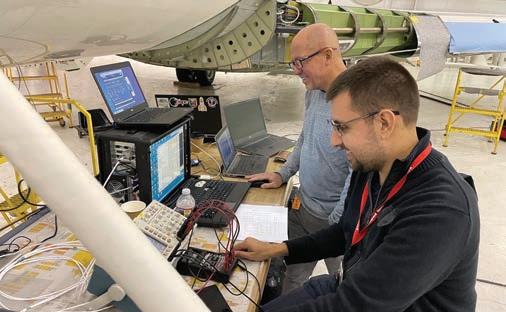
ainonline.com \ September 2023 \ Aviation International News 25
Collins Aerospace continued
HONEYWELL
UNIVERSAL AVIONICS
Universal Avionics, which drew an overall rating of 8.0 in the 2022 survey, did not draw enough responses to be included in this year’s survey.

THE IMPROVEMENTS:
Universal Avionics bolstered its international presence with a new office opened in Blagnac, France in May that provided a larger workspace compared with its previous Toulouse office and extended its capabilities in Europe to meet the growing demand in the region. Along those lines, the company appointed Fabrice Arfi as general manager of Universal Avionics International.
In addition, in the U.S. the company increased its repair portfolio, being named an approved repair center for the Dassault FalconEye enhanced flight vision system.
The improvements come as Universal in recent years consolidated services and support into one organization and launched a new department, Support Services, that consolidated the administration of database services, repairs, exchanges, rentals, loaners, used parts sales, and extended warranties. Robert Clare, director of customer services, said, “By consolidating, we were able to streamline processes through all these services.”
GULFSTREAM
Sharing the top spot for cabin management system support with Textron Aviation, Gulfstream posted an 8.1 total score in the grouping, representing an improvement of a tenth of a point over its score from last year. Highlights included top scores in warranty fulfillment (9.2) and technical reps (9.1). However, cost of parts (6.6) and cost of per hour programs (7.5) weighed on Gulfstream’s overall score. Meanwhile, its score of 8.7 in AOG response placed it in a tie for the lead position with Textron Aviation in that category.
THE IMPROVEMENTS:
Gulfstream’s avionics support team has sharpened its focus on preparations for the G700’s entry into service while the company’s new product development unit evaluates technology features and functions of cabin management
systems (CMS) to meet evolving customer demands. The company says it has enhanced its CMS options to include larger, higher-resolution onboard monitors and more

Aviation International News \ September 2023 \ ainonline.com 26
options for integrated use of personal devices. Other expanded features include more use of Bluetooth, wireless charging, and seamless audio and video streaming. Gulfstream also continues work on integrating expanded LED lighting options,
including customized color, intensity, and automation choices.
“We’re excited to further expand our existing catalog and have the opportunity to incorporate some of the new features into the existing fleet,” the company said.
TEXTRON AVIATION
Registering a two-tenths of a point improvement from its total score in 2022, Textron Aviation finds itself with a share of the top position in cabin management grouping with Gulfstream. Highlights included an 8.0 score in cost per hour programs and the leading position in cost of parts, albeit with a 7.2 rating. Textron also placed first in technical manuals (8.3) and tied for first in AOG response (8.7). Apart from placing second in the grouping’s technical reps category with an 8.9 rating, Textron Aviation finished with largely middling scores across most of the remaining categories.
THE IMPROVEMENTS:
Along with efforts to bring to market new features in newly delivered aircraft, Textron Aviation continues to invest in new technologies to mitigate aircraft obsolescence such as controller-pilot data link communications (CPDLC) systems and autothrottles for fielded aircraft. In the passenger cabin, offerings include multiple highspeed internet connectivity systems, including air-toground systems and Iridium satcom installations.
Separately, cabin comfort retrofits can include moving map displays, USB port installations, and cabin lighting upgrades to LEDs. Textron Aviation also offers what it calls “forward-thinking upgrades” such as the Garmin G5000 for the Citation 560 Excel/XLS and Beechjets, Collins Pro Line Fusion for the Cessna Citation 1+/2+/3, Garmin G600 for the Citation Jet, and Primus Epic FANS/CPDLC upgrades for the Citation Sovereign and Hawker 4000.
TECHNIK
Lufthansa Technik, which posted an overall average of 7.0 in the cabin management system category last year, did not garner enough responses to be ranked this year.
THE IMPROVEMENTS:
What Lufthansa Technik calls a “major field of action” around its support efforts involves managing supply
chain disruptions—largely semiconductors—caused by the Covid pandemic and ongoing military conflicts around the world.
In response, the company has expanded its production capabilities through vertical integration within its value chain and gaining control over the manufacturing of electronic subparts for its Nice cabin management

ainonline.com \ September 2023 \ Aviation International News 27
Gulfstream continued
LUFTHANSA
system and other business aviation products. According to Hinnerk Noelker, Lufthansa Technik director of OEM engineering and operations, the move has not only improved product quality but delivery schedules, thereby increasing overall efficiency and making it a reliable support partner.


Over the past several months the company has placed special emphasis in guiding and consulting business jet owners and operators in how to address obsolete cabin management and inflight entertainment and connectivity (IFEC) systems, added Noelker. “To ensure we meet these needs, we have established a robust network of MRO channel partners,” he explained. “Currently, we offer tailored upgrades specifically designed for the Bombardier Challenger 300 model. One of our notable options is the HD Upgrade+, which enhances the SD systems on the Challenger 300 by upgrading them to high definition and introducing new features such as Bluetooth, moving map improvements, sound options and display upgrades.” The company also offers a retrofit kit for the Challenger 300, replacing the obsolete audio technology with the NiceH D system.
Now developing a new software platform for the Nice system, Lufthansa Technik expects its effort to not only enhance the “digital experience” but streamline operations. Offering more personalized products and features, the software platform will establish a seamless connection between the aircraft and the cloud. With a ground portal, a ground cellular connection, and
various on-demand features, it will also allow for continuous updates.
Finishing first among the companies that registered enough responses for inclusion in the airborne connectivity grouping, Satcom Direct improved on its 8.4 score from 2022 by two-tenths of a point. It’s overall rating of 8.6 this year resulted from particularly high scores in warranty fulfillment (9.1), AOG response (9.0), and technical reps (9.5). Comparatively high scores were received for cost of parts (7.4) and cost per hour programs (7.6), also having an effect on Satcom Direct’s total score.
THE IMPROVEMENTS:
For Satcom Direct, effective support starts with training, a principle reflected in its expanded curriculum for operators meant to improve the functionality of products related to connectivity, cybersecurity, and the inflight experience for passengers. Over the past year, the company has also made training more accessible through third parties such as FlightSafety International and Da Vinci Inflight Training Institute.
Aviation International News \ September 2023 \ ainonline.com 28
SATCOM DIRECT Lufthansa Technik continued
This year also saw Satcom Direct’s launch of an update to what it calls the industry’s only certified aviation IT training program, called aeroIT. Once complete, technicians gain a three-year certification for the configuration and troubleshooting of information processing networks and communication systems. The four-day program concentrates on four areas of discipline: satellite networks, IP network theory, troubleshooting aircraft networks, and network management.
Meanwhile, as Satcom Direct adds more hardware and software products, its customer support team continues to expand to support its “follow the sun” philosophy of providing round-the-clock support of products such as the Plane Simple Ku-band satcom antenna.
“Throughout the installation and the entry into service process, Satcom Direct constantly updates the customer to support the flight department’s familiarity with the

systems,” said the company. “We provide candid and transparent information and find that this iterative process supports a greater understanding of the full potential of the customized connectivity solution.”
GOGO BUSINESS AVIATION
Finishing second among the companies drawing enough responses for inclusion in the airborne connectivity group, Gogo Business Aviation saw its overall score improve from 8.2 in 2022 to 8.3 this year. It recorded its highest individual scores (8.9) in the warranty fulfillment and technical representatives’ categories while placing even with Honeywell in cost per hour programs (7.4) and overall reliability (8.3). Its score in the technical reps category placed it second out of the companies in the connectivity category and a half point ahead of Honeywell.

THE IMPROVEMENTS:
Gogo continues to invest and expand its team of data scientists and engineers who extract data produced by the company’s Avance interconnectivity platform. Called the market intelligence team, the group provides insights and actions to better understand meeting customer expectations and areas in need of improvement.
The Gogo Avance systems produce about a million messages per day, providing information and details such as LRU health (voltage, fan speed, temperature); systems usage (number of devices, data usage, etc.); and connection status to Gogo’s air-to-ground (ATG) network. “We believe this team is one of a kind in business aviation and we will continue to invest in it as we expand our product portfolio and grow our customer base,” said Dave Glenn, senior vice president of customer operations. “[Our market reach extends] from North America but also around the world with our Gogo Galileo (global satellite broadband) service, powered by Avance and operating on a low Earth orbit (LEO) satellite network.”
Using much of the information provided by the market intelligence team to design what the company calls proactive outreach
ainonline.com \ September 2023 \ Aviation International News 29
Satcom Direct continued
for its customers, Gogo recently launched a new customer success initiative using an algorithm to help the support team better understand when a customer might need assistance.
Finally, Gogo has completed 5G network construction in the continental U.S. and started expansion into Canada with a “handful” of sites already completed to provide additional coverage to business aviation operators in North America.

The system will meet all requirements for its 5G service, providing 25 Mbps on average and reaching peak speeds in the range of 75 to 80 Mbps range for video conferencing, live TV, and gaming with lower latency and higher throughput. Having readied its 5G network in the U.S., Gogo expects to launch the service in 2024. It added that it expects to complete its Canada installation early next year.
New-entrant airborne connectivity supplier SmartSky did not draw enough responses for inclusion in the rankings.
THE IMPROVEMENTS:
A relatively new entrant into the inflight connectivity space, SmartSky deployed its U.S. nationwide air-to-ground network in July 2022. Since then, it has gathered data from flight testing of the software-defined network to adjust network performance and optimize the customer experience.
During this year’s second quarter, SmartSky rolled out its seventh revision to its aircraft base radio software that further improved operational stability and reliability, as well as an update to the back-end services on the ground network. It based the enhancements on data gathered during ongoing company flight testing, customer flights, and monitoring of the network.
Other developments included the deployment of Honeywell Forge software to manage, track and control customers’ inflight connectivity services, cost, and performance for the cabin and flight deck. With its deployment, SmartSky became the first and only air-to-ground provider to deploy Forge capabilities.
Meanwhile, SmartSky reported significant developments in Service Management Platform (SMP) capability for real-time visibility to customer performance, allowing the network team to proactively monitor and address site and sector issues across the network and to notify the product support engineering team if a customer experiences service performance degradation The product support engineer can then notify the customer, enabling an optional flight route change should a temporary loss of connectivity occur. The
SMP also allows the product support engineering team to monitor a specific tail live, in-flight, and prepare for proactive customer contact after the flight.
Finally, SmartSky introduced its SmartCart ground testing kits to installation partners. Calling it the first mobile ground testing device for an air-to-ground connectivity system, SmartSky provides one kit to partners upon their first hardware install. SmartCart functions as a portable site on the SmartSky ATG network, with its own unique site ID. SmartSky onboard hardware systems attach to the SmartCart site across a localized RF link using SmartSky communications protocols, connect to the SmartSky core network, and pass data to and from the aircraft, just as they do in the air. The data flows through SmartSky’s network backhaul and points of presence through a secured VPN connection on a ground cellular network. The VPN keeps all data private, even during testing. SmartCart can validate activation and all system functionality, generally in less than an hour.
Aviation International News \ September 2023 \ ainonline.com 30
SMARTSKY
Gogo Business Aviation continued
Gogo AVANCE = Connectivity +

NBAA-BACE, Las Vegas, NV | October 18, 2023 | 12–1:30 pm

Hosted by:
Sponsored by:
Join us for lunch on October 18th at NBAA in Las Vegas to hear from a distinguished panel of experts who will discuss how Gogo AVANCE gives you more than just great Wi-Fi in the sky.

Learn why selecting the right solution sets you up for everything you need now and everything that comes next - saving you from unforeseen costs, inconvenience, and downtime.

Gain a deeper understanding about:
+ Supporting you for the long-haul with seamless technology upgrades and sustainable design
+ Integrated remote support, insights, and account management
+ Over-the-air updates and diagnostics for reduced downtime
+ Stronger ROI and ongoing principal satisfaction
Register today
connect.ainonline.com/nbaa-lunch-2023
Circling approach: Is it your best option?
BY STUART “KIPP” LAU
Circling approaches are the most dangerous of all approaches, especially when flown at night or in marginal weather conditions. As an extension of an instrument approach, a circling approach is the “visual segment of an approach,” often flown at low altitude, low airspeed, and with no lateral or vertical guidance to a runway. Accepting a clearance to fly a circling approach is risky business and there is no room for error.
Since 2008, according to the National Transportation Safety Board (NTSB), there have been 10 major accidents involving Part 91 and Part 135 aircraft flying a circling approach. On average, that is one fatal accident every 18 months, where an aircraft either loses control or impacts terrain while attempting a circling approach.
According to a Flight Safety Foundation study, a straight-in instrument approach is a much better alternative and is 25

times safer than a circling approach; adding vertical guidance to an approach will increase the safety margin by another eight times.
For reasons unknown, other than convenience or “operational flexibility,” some operators and pilots of business aircraft continue to accept the risk of flying a circling approach, while other operators take a much more conservative route and either prohibit them or place restrictions on circling approaches.
In March, following a series of business jet accidents, the NTSB issued a safety alert (NTSB Safety Alert Number 84) that cautioned pilots of the complexities and risks associated with flying a circling approach. The NTSB advises pilots to “know the risks before conducting a circling approach to be sure that it is the best and safest option and to brief the approach, plan its execution, and acknowledge your own limitations.”
Prior to the publication of the NTSB safety alert, the FAA cautioned pilots of the dangers of flying a circling approach in its Instrument Procedures Handbook and in the Aeronautical Information Manual (AIM).
The Instrument Procedures Handbook states, “Circling approaches are one of the most challenging flight maneuvers in the NAS, especially for pilots of Category C and Category D turbine-powered transport category airplanes. These maneuvers are conducted at low altitude, day and night, and often with precipitation present affecting visibility, depth perception, and the ability to adequately assess the descent profile to the landing runway.”
The AIM 5-4-20(f) further cautions, “Circling may require maneuvers at low altitude, at low airspeed, and in marginal weather conditions. Pilots must use sound judgment, have an in-depth knowledge of their capabilities, and fully understand
Aviation International News \ September 2023 \ ainonline.com 32
Safety
The pilots flying a Learjet 35A (similar to this one) to Teterboro on a gusty day didn’t properly brief nor fly the circle-to-land approach and crashed turning toward Runway 1, according to the NTSB.
the aircraft performance to determine the exact circling maneuver since weather, unique airport design, and the aircraft position, altitude, and airspeed must all be considered.”
In its safety alert, the NTSB highlights three recent fatal accidents involving business jets flying circling approaches. In each case, the flight crews of the accident aircraft followed a disastrous script that was eerily similar to the cautions published earlier by the FAA.
CIRCLING MISHAPS
In May 2017, the pilots of a Learjet 35A, on a Part 135 repositioning flight, stalled and crashed while attempting a circle-to-land approach at New Jersey’s Teterboro Airport (KTEB). The weather at the time was daytime VMC with strong northwesterly winds at 19 knots gusting to 29 knots.
The flight crew had been cleared for the ILS Runway 6 approach, circle to Runway 1 at KTEB. ATC issued this approach clearance 50 nm from the airport; this approach clearance is a common practice at KTEB to accommodate traffic flow.

Unfortunately, the pilots never briefed the approach and due to a series of procedural deviations and errors had difficulty becoming established on the approach. Twice during the approach, ATC reminded the pilots of the final approach fix (FAF) altitude—the aircraft subsequently crossed the FAF “hundreds of feet” high.
Rather than beginning the circling maneuver at the FAF, as instructed by ATC, the aircraft continued toward Runway 6 at an altitude higher than required. Approximately one mile from the end of Runway 6, the crew began the circling maneuver toward Runway 1. At this point, they were too high and too close to Runway 6 to align with the landing runway. The flight crew continued to maneuver towards the runway, but the airspeed decreased during the turn, and the aircraft stalled and crashed one mile short of Runway 1. Both pilots were fatally injured in the crash.
The NTSB found that, “The flight crew had multiple opportunities to recognize and discontinue the unstabilized
approach, most notably during the circling segment of the approach. Their lack of situational awareness could have been prevented by briefing the approach and following ATC instructions to become established on the approach and safely maneuvering to land.”
In another crash, in July 2021, the pilot of a Bombardier Challenger 605 lost control during a circling maneuver near the Truckee-Tahoe Airport (KTRK) in Truckee, California. Both pilots and four passengers were killed in the crash.
As the aircraft neared KTRK, ATC advised the crew to expect the RNAV (GPS) Runway 20 at KTRK due to ATC flow control “constraints.” The flight crew originally planned the RNAV (GPS) 11 approach but accepted the approach to Runway 20 and then requested to circle to Runway 11 (a longer runway) for landing performance considerations.
At the time of the accident, the weather was reported as 4 miles visibility (with smoke), a broken cloud layer at 2,300 feet agl, and wind from the west at 11 knots gusting to 16 knots. The visibility was reported to further decrease to as low as 3 miles as the aircraft approached the airport.
Approximately 10 nm north of Runway 20, the flight crew “checked in” with the tower. The tower controller offered either a left downwind for Runway 29 or Runway 11. The flight crew reported Runway 11 in sight and began a right turn to enter the left downwind for Runway 11. Next, the aircraft continued to circle past the extended centerline of Runway 11 and entered a nose-down attitude in a steep left turn, and crashed short of the airport.
ainonline.com \ September 2023 \ Aviation International News 33
When strong winds blow from the northwest, pilots landing at Teterboro are often instructed to fly the ILS Runway 6 approach, then circle to Runway 1, which can be a challenging maneuver.
...the aircraft... continued to circle past the extended centerline of Runway 1...
According to the NTSB, “the flight crew had many options available to them that would have increased the likelihood of executing a stabilized approach and successful landing, such as: requesting the approach they originally planned for, briefing the approach they accepted, or performing a missed approach procedure.”
Five months after the Challenger accident in KTRK, a Learjet 35A struck the powerlines and crashed near Gillespie Field (KSEE) in El Cajon, California while performing a circling approach at night in deteriorating weather conditions. The weather at the time of the accident was 3 miles of visibility and a broken cloud layer at 2,000 feet agl.
This flight was operated as a Part 91 repositioning flight that originated at the John Wayne/Orange County Airport (KSNA) in Santa Ana, California. After a short flight, the flight crew initiated the GPS Runway 17 approach and were cleared to land on Runway 17. Shortly afterward, the pilot requested to land on Runway 27. The controller instructed the pilot to overfly the airport and enter left traffic for Runway 27R and cleared the aircraft to land.
ADS-B data indicated that the aircraft overflew the airport at 407 feet agl and then began a climbing turn to align with Runway 27R. The aircraft struck power lines and impacted the ground about a mile from the end of the runway. Both pilots and two flight nurses were fatally injured.
The NTSB noted that: “Instead of attempting a landing from an unstable approach in poor visibility, the flight crew could have initiated a missed approach procedure and attempted a landing to a different runway or diverted to another airport due to the weather.”
NTSB IDENTIFIES THE PROBLEM
Circling approaches, according to the NTSB (and as demonstrated in these accidents),
are problematic for several reasons:
Circling approaches can be riskier than other types of approaches because they often require maneuvering at low altitude and low airspeed during the final segment of the approach, increasing the opportunity for loss of control or collision with terrain. These risks are heightened when conducting circling approaches in marginal or reduced visibility conditions and increased focus is required.
While circling approaches might be necessary to accommodate traffic flow at airports, or are advantageous due to wind conditions, pilots sometimes do not evaluate the risks of these approaches fully before accepting them, which can result in unstabilized approaches.
appropriate power setting, landing checklists, and a heading that ensures only small changes are necessary to maintain runway alignment. Guidance and tips that, in most cases, the approach should be stabilized by 1,000 ft in instrument conditions or 500 ft in visual conditions. If the approach becomes unstabilized at any time after that, go around.”
PILOT AND ORGANIZATIONAL TAKEAWAYS
The NTSB safety alert on circling approaches is aptly titled “Know the Risks!” Pilots must fully understand the risks involved when flying a circling approach and use sound judgment before accepting a clearance to fly a circling approach. Is it your best option?
Often, circling approaches do not allow for stabilized approach criteria to be met. Approaches should be stabilized by 1,000 feet height above touchdown (HAT) in instrument conditions, and by 500 feet HAT in visual conditions.
When circling approaches are conducted in IMC, transitioning from instruments to ground references can cause the “illusion of high speed” if the instruments are not properly monitored.Operators are encouraged to establish, publish, and adhere to stabilized approach criteria; these criteria may restrict or prohibit an operator from circling approaches.
NTSB Safety Alert Number 77–March 2019, titled “Stabilized Approaches Lead to Safe Landings,” recommends operators to: “Follow SOPs and industry best practices for stabilized approach criteria, including a normal glidepath, specified airspeed and descent rate, landing configuration (flaps, gear, etc.),
Consider your personal experience, proficiency, and other limitations when planning to fly a circling approach. Is the weather close to minimums? Is it nighttime? Are you familiar with the airport and terrain surrounding the airport? Again, there are other options such as requesting a straight-in approach to a different runway or diverting to a more suitable airport.
From an organizational perspective, “know the risks!” Circling approaches present both safety and liability risks. The safety risk is well-defined; a straight-in approach is 25 times less risky. The liability risk is less defined.
An operator may argue, “A circling approach is a legal procedure that has been certified by the FAA (or other authority).” Another point of view will argue that a circling approach will allow access to second and third-tier airports, which provides a marketing advantage.
All are interesting points, but at the end of the day, ask yourself and your legal counsel this question: Does the “operational flexibility” of flying a circling approach outweigh the liability if there were an accident? z
Aviation International News \ September 2023 \ ainonline.com 34
Safety
A circling approach is a legal procedure that has been certified by the FAA (or other authority).
FUTURE OF THE AEROSPACE
THE INDUSTRY
USE CODE: AVAIN23
Attracting the biggest players in the aerospace, space and defence industry, Dubai Airshow 2023 is all set to be another world-class edition for the industry’s trailblazers and innovators to showcase, identify future trends and opportunities and close winning deals.
www.dubaiairshow.aero |








Strategic partners:


17



NOVEMBER 2023
DWC, DUBAI AIRSHOW SITE

Supported by:
NOW
REGISTER
Jessica Cox plans round the world flight
BY MARK HUBER
Jessica Cox is the first pilot certified to fly only with her feet. Now she wants to become the first armless person to fly around the world.

A motivational speaker, author, disability advocate, and philanthropist, Cox earned her light-sport pilot certificate in 2008, flying a 1946 ERCO Ercoupe. Built to go low and slow, the two-seat aircraft has ailerons interconnected with the rudder, which means disabled pilots can fly it with their feet off the floor using only the control yoke.
Cox vividly remembered her first solo flight while speaking with AIN in the Homebuilt Hangar at this year’s EAA AirVenture show in Oshkosh, Wisconsin. “I felt like I was on top of the world. I was never more focused in my life. My heart was pounding and I was excited and nervous at the same time,” she said. Today, Cox counsels others with physical disabilities who want to enjoy life in the cockpit.
Flying is far from her only accomplishment. When she was 14, Cox earned her first black belt from the International Taekwon-Do Federation. After graduating high school, she attended the University of Arizona, where she earned a bachelor’s degree in psychology. At the university, Cox joined an ATA Martial Arts club (formerly known as the American Taekwondo Association) and became the first armless person to earn a black belt in the ATA.
In 2012, she married her Taekwondo instructor, Patrick Chamberlain, who also is a pilot and today serves as her business manager.
Cox spoke with AIN in front of the cockpit of a wrecked Van’s Aircraft RV-10 kit plane that she and her team of volunteers are using to test a variety of customized seats, flight control systems, and doors that could make aviation more accessible
to people with disabilities. These components will be fitted to a new-build RV-10, a low-wing, four-seat aircraft that a local EAA chapter in New Jersey is building for Cox with help from engineering students. It is the airplane Cox hopes to fly around the world in 2028, culminating with overflights of the International Olympic and Paralympic Games in Los Angeles.
Cox calls it her “impossible airplane.” It features a pair of blue Crocs attached to the rudder pedals, which control the pitch, roll, and yaw axes. Floor-mounted levers between the pedals control throttle and the flaps. Plans call for modern glass panel avionics with optional voice controls for settings like radio frequencies and cabin environmental controls.
The right-seat pilot position will be fitted with conventional flight controls, allowing Cox’s husband Patrick and other pilots to fly the aircraft as well. Besides the around-the-world trip in 2028, Cox plans to use the aircraft to motivate disabled children to reject the notion of physical limitations.
Advocating for disabled children is a passion for Cox. To that end, in 2017, she founded the Rightfooted Foundation International (RFI), a nonprofit organization. One of RFI’s first projects was a YouTube video series called “Life With Feet.” The first episode, which highlights how Jessica and her friend Tisha navigate life without arms, garnered more than 750,000 views.
Cox thinks universal design and artificial intelligence hold enormous promise for assisting the disabled to lead fuller lives, but she believes more work needs to be done to equalize opportunities both in the U.S. and abroad so that “everyone feels included”—a message she delivers on her international speaking tour.
People with disabilities, Cox said, “want to work, want to be able to provide for themselves and their families, [and] want to have a feeling of independence and empowerment. Getting up every day and doing something gives you a purpose.”
Jessica Cox has let nothing stand in the way of finding hers. z
Aviation International News \ September 2023 \ ainonline.com 36
EAA AirVenture 2023
Two dextrous feet are all Jessica Cox needs to fly her 1946 ERCO Ercoupe.
News from EAA AirVenture Oshkosh
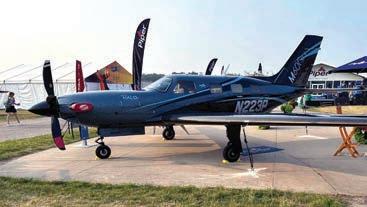 BY AIN STAFF
BY AIN STAFF
Primus Apex avionics on the othe r side.
The Experimental Aircraft Association’s 2023 edition of AirVenture set numerous records, from the 667,000 in attendance to the 13,000 campsites (accounting for 40,000 visitors) and the 5,500 volunteers. More than 10,000 aircraft arrived for the event that spanned from July 20 to 30 at Wittman Regional Airport in Oshkosh, Wisconsin. Impressively, the event drew from 93 countries (tying a record) and had key participants such as the U.S. Air Force Training Command and NASA, which brought its Super Guppy that was designed to haul large space equipment. Typically, this year’s AirVenture also generated lots of news. Here’s a sample of the headlines.
HONEYWELL PC-12 WITH ANTHEM AVIONICS FLIES TO OSHKOSH
While the Apex pilot interface is a cursor- control device and multifunction controller, Anthem’s displays are all touch display units (TDUs), or touchscreens, enabling many more ways of activating all of its features.
“It’s completely different architecturewise,” Manning said. Areas on the TDUs—for example, the flight mode annunciators—can even replace all the functions of a typical hardware guidance panel, and aircraft manufacturers will be able to choose whether the panel is needed or if the space can be put to other uses.
The main interface for Anthem is the pilot interface display unit, which can be on its own or can be included in a section of one or more of the TDUs.
WISK FLIES EVTOL AUTONOMOUSLY, UNMANNED AT AIRVENTURE
Wisk Aero autonomously flew its fifthgeneration “Cora” eVTOL technology demonstrator at EAA AirVenture. The aircraft made several passes in front of the airshow crowd line and transitioned from hover to wing-borne flight four times. The unmanned flight also included multiple maneuvers, among them hover and 360-degree pedal turns.
“This demonstration showcases the state of readiness for autonomous technology and electric propulsion,” said Wisk CEO Brian Yutko. “We look forward to launching the first passenger service on an all-electric, autonomous air taxi within this decade.”
PIPER AIRCRAFT SEES RECORD DEMAND
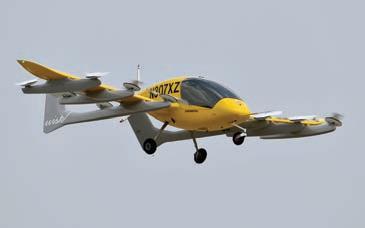
As flight testing of the new Anthem avionics suite in Honeywell’s Pilatus PC-12 continues, the turboprop single took a short break in Oshkosh, Wisconsin, where EAA AirVenture attendees were able to check out the revamped instrument panel up close.

Honeywell test pilot Ed Manning made the first flight earlier this year of the PC-12 fully equipped with the Anthem suite. Flight testing, which began in the PC-12 more than a year ago, was with a partial Anthem system mounted on one side of the instrument panel, supported by original Honeywell
This was the first public demonstration of the Wisk fifth-generation aircraft, and the flight was monitored by Wisk controllers in a mobile ground station at the show site in Oshkosh, Wisconsin.
Piper Aircraft expects to deliver 270 aircraft this year, up from 236 in 2022. During AirVenture, company v-p of sales, marketing, and customer support Ron Gunnarson characterized the market as “the best many of us have ever seen,” with dealer inventories of new M-class airplanes, as well as Seminoles and Archers, at “near zero” and available used inventories of M-class aircraft at less than 3 percent. He called market conditions, coupled with continuing supply-chain challenges, “both a curse and a blessing” that was forcing the company to “keep it real” and not over-expand during the current boom.
Gunnarson said Piper’s bottom line continues to be strengthened by large fleet orders for training aircraft, including one announced earlier this year from Blue Line Aviation in North Carolina for up to 115 aircraft. He also noted strong demand for the company’s Archer DX turbo-diesel engine training aircraft from foreign markets.
According to Gunnarson, Piper is meeting the challenge of increased demand with a $30 million modernization of plant and equipment that includes robotic welders and 3D printers. z
ainonline.com \ September 2023 \ Aviation International News 37
EAA AirVenture 2023
The not-so-new vision of air taxis
BY COLLEEN MONDOR
Last May, the FAA released an airspace blueprint as guidance to potential changes to airspace and procedures in the accommodation of future air taxis. A short accompanying video noted that air taxis would operate initially in the existing helicopter and heli-path structure, require onboard pilots actively flying the aircraft, and follow all applicable aviation regulations.
If this all sounds familiar, it is; it is similar to how air taxis, regulated by Part 135 of the Federal Aviation Regulations and including fixed-wing aircraft, have operated for decades.
In the discussion of the blueprint, which is available online, the agency failed to note the current existence of air taxi operations or their long-storied history in commercial aviation.
In federal records, the term “air taxi” dates to 1921 in an interesting mention in the Congressional Record. In August of that year, California Rep. Charles Curry introduced a bill to establish a federal Department of Aeronautics. His remarks extolled
the virtue of aviation in both its civil and military capacities, including a list of common uses for the airplane with 34 separate categories such as sports, landscape gardening, commercial financial transactions, and fisheries. Under the category “Service—Special Dispatch,” he noted passenger-carrying, sightseeing, regular air taxi service, commercial routes between cities, and hotel service. (The hotel uses of aviation were apparently to transport guests to “golf links etc.”)
MEDIA ATTENTION
Air taxis could be found in the major media around the same time. The New York Times reported in June 1919 that North Shore Aerial Transportation Service had completed a nine-minute flight in Massachusetts from Swampscott to Boston. The company planned continued flights throughout the summer.
A short article in the November 1921 issue of Popular Mechanics heralded what was believed to be the longest air taxi flight
to date. Under a headline of “4,250-mile ‘Air-Taxi’ Trip Made Without Incident,” the magazine detailed a business flight that left Paris on August 25 and then proceeded to stop in fourteen cities across Europe before its return on September 15.

Reports of air taxi service in various parts of the U.S. continued in the ensuing decades, with Portland reporting in 1926 that Rankin Air Service carried 65 people to various locations in one day, charging each 25 cents per mile.
Elsewhere, an Ohio family en route to Miami, Florida in 1930 reported an air taxi trip throughout the Caribbean, and in 1938 air taxi service arrived in Chicago with a shuttle service from the lake shore to the airport, and a floatplane air taxi expected to open soon as well.
After observing the slow proliferation of these non-airline commercial activities for some time, in 1951 the federal government weighed in with specific regulations. As posted in the Federal Register in February of that year, the Civil Aeronautics Board
Aviation International News \ September 2023 \ ainonline.com 38
The first production prototype of the Joby eVTOL, which will likely be one of the first eVTOL air taxis in the U.S.
(CAB) defined air taxis as air carriers that were not required to obtain a certificate of public convenience and necessity (due to non-scheduled service), and exclusively used aircraft of less than 12,500 pounds maximum takeoff weight. The exemption from the air carrier certificate requirement could be revoked by the CAB at any time.
Other than within the territory of Alaska, (which was governed by a separate set of regulations), there were several specific rules enacted to govern how air taxis could fly between two points, stressing that such operations could not constitute a “uniform pattern of normal consistency.” Air taxis were charters, but ambiguity remained in some differences between them and air carriers. Even after Part 135 was developed in 1964, gray areas persisted.
In 1972, the National Transportation Safety Board (NTSB) published a special study into air taxi safety and in the process delved into the extensive history of air taxi operations and regulations. While not a definitive history of air taxis in the U.S. (the study’s authors did not address air taxi proliferation in the 1920s and ‘30s), it is a significant document for the period.
It references the National Air Taxi Conference, which was formed in 1950 by air taxi operators focused on passenger traffic. The study also reports on the massive growth of the air taxi and commuter sector of the industry and notes the CAB’s establishment of the commuter air carrier category in 1969, which applied to those air taxis conducting five weekly round trips between two points and publishing flight schedules, or having a USPS contract to fly the mail.
The air taxi/small commuter split as it exists today came out of the development of that separate category in 1969.
So, from a historical and regulatory standpoint, the long development of the operations known as “air taxis” is easily documented. And yet, we cannot resist using the term for the latest iteration of nonscheduled, short-distance flight availability.
On July 18, The New York Times ran an article discussing the FAA’s anticipation of a competitive air taxi market by 2028. The reporter described eVTOL aircraft as those finally able to transport people from the “middle of cities” to airports or vacation destinations but noted they would likely face resistance from locals who might consider the smaller aircraft as hazardous or annoying.
The potential market for short-flight operators was estimated as much as “tens of billions of dollars.” The newspaper was presenting air taxis as brand-new technology and brand-new activity.
For all that, it sounds remarkably like how charter helicopters already operate, (right down to potential noise complaints). Yet again, the air taxi business was being introduced to the public.
ENDLESS APPEAL
How do we repeatedly suffer from collective amnesia concerning a significant portion of the aviation industry? The problem might lie in the endless appeal of the term “air taxi.” No matter how the aviation industry and regulators have defined short charter flights, the general public continues to chase the dream of fully automated aviation transport that will appear on demand right outside their homes and whisk them off to work or play.
How to accomplish this level of transport cheaply, safely, and within existing aviation infrastructure remains a key question mark in the fanciful air taxi vision. Yet that vision keeps capturing attention.
Popular Mechanics predicted in 2005 that within 20 years, there would be a fleet of 13,500 economical four-passenger microjets in small airports across the country offering air-taxi service at the price of an economy-class airline ticket. That didn’t happen.
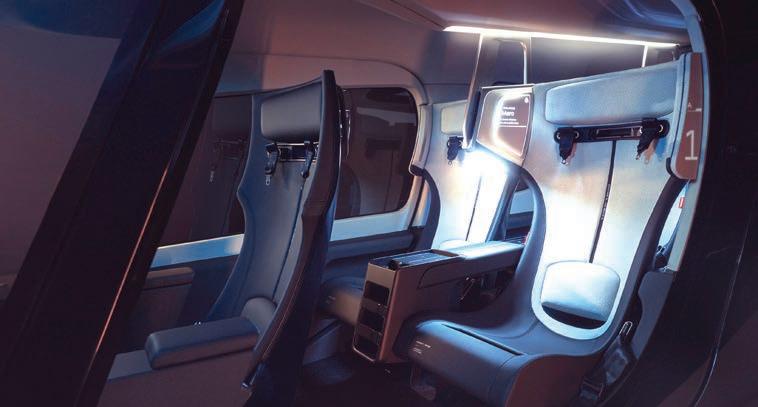
At the end of the day, no matter how many articles are written touting air taxi operators as mysterious futuristic entities, nothing has changed where it matters, which is safety regulation with the FAA.
Whether or not it matters that air taxis have been flying for over 100 years isn’t up to the FAA. However, the term has fallen victim to a collision of futuristic dreams and modern marketing.
In 1972 the NTSB noted that the act of hiring an air taxi was so similar to the hiring of a taxicab that it had obtained the name through its “identification as ‘air taxi’ service.” The image in our heads of cheap, compact flying yellow taxi cabs is too alluring to apply to an ordinary old Cessna 206 or Airbus Helicopters Astar. Air taxis will be the stuff of the Jetsons. Maybe, finally, this time it will really happen. And it will be affordable; we are sure of that too—otherwise, it wouldn’t be called a taxi. z
ainonline.com \ September 2023 \ Aviation International News 39
The Archer Midnight eVTOL aircraft fits squarely in the air taxi category.
Runway excursions: Does the hype about causes and types match with reality?
BY GORDON GILBERT
There is an old axiom among pilots that says the three most useless things in aviation are fuel on the ground, air above, and runway behind.
In the context of “runway behind,” similar themes thread through many runway execursions: an unstabilized approach, an attempt to salvage it instead of making a go-around, a short final too hot and high, a touchdown too long and too fast, improper use of braking and other slowing systems, and a delayed or improper decision leading to being unable to stop the aircraft before running out of control, options, and ultimately, runway.
These themes were found in an AIN review of 164 excursions (33 percent) out of a total of 494 reported accidents and incidents of a selected group of aircraft make and models starting from the year when these airframes entered service.
(FAA defines a runway excursion as a “veer off or overrun from the runway surface.”)

Our study mirrored the results of previous studies—runway excursions account for about a third of all reported accidents/ incidents. Charter operations accounted for nearly 20 percent of business jet excursions worldwide.
The jets in our study comprised 11 models, four of them approved for single-pilot operations. They are the HondaJet, Embraer Phenom 100, Raytheon Premier, Cessna Citation 550 and Citation 560XL, Gulfstream large-cabin series, Dassault Falcon 900, Bombardier Challenger 300 and 600 series, and Learjet 45 and 55.
In addition, AIN performed a separate NTSB search for incursions that captured 67 occurrences from 2008 through 2022 for which the investigation was completed.
Besides unstabilized approaches leading to hot and long landings, other predominant implicating and frequently overlapping causal factors include loss of directional control on ground (LOC-G), system malfunctions, maintenance errors, contaminated runways, unfamiliarity with aircraft systems or procedures, failure to use checklists, and a lack of cockpit resource management (CRM). See the table on the facing page for a complete list.
SOMETIMES FATAL
Excursions typically do not result in fatalities, but there are exceptions. Five fatal landing excursions and three fatal takeoff excursions took the lives of 32 crew and passengers. Two of the accidents occurred under Part 135 and two of the three fatal excursions outside of the U.S. were charters.
Aviation International News \ September 2023 \ ainonline.com 40
The NTSB found an improperly installed wheel caused this HondaJet to depart the runway after landing at Atlanta’s Cobb County Airport.
The worst fatal excursion in terms of loss of life (seven perished) was on May 31, 2014, when a Part 91 Gulfstream G-IV crew attempted to takeoff with its gust locks engaged. There were so many issues surrounding this accident that the NTSB published a special investigation report and issued more than a dozen recommendations.
The other G-IV takeoff fatal excursion was on Oct. 30, 1996, and the sequence of events started when the aircraft began its takeoff roll in a 24-knot crosswind. About 1,340 feet after the start of the takeoff roll, the airplane veered left and departed the runway. Tire marks indicated no braking action was applied. One of the pilots said, “Reverse,” then the other pilot said, “No, no, no, go, go, go, go, go.” As the airplane traversed a shallow ditch that paralleled the runway, it began shedding parts and became airborne after it encountered a berm at the departure end of the runway. The aircraft caught fire and all four souls on board perished.
The nose wheel steering select control switch was found in the “Handwheel Only” position, and not in the “Normal” position. The pilot and copilot comprised a mixed crew in accordance with an interchange agreement between two companies that operated G-IVs. The companies’ operation manuals and the interchange agreement did not address mixed crews, procedural differences, or aircraft differences training.
Probable cause of this accident was the failure of the pilot-in-command (PIC) to maintain directional control of the airplane in a gusty crosswind, his failure to abort the takeoff, and “failure of the copilot to adequately monitor and/ or take su ffi cient remedial action to help avoid the occurrence.” Factors relating to the accident included the gusty crosswind, the flight crew’s inadequate preflight, the nose wheel steering switch in the “Handwheel Only” position, and the lack of standardization of the two companies’ operations manuals and interchange agreement.
Disturbing issues regarding the flight crew and the operator were also discovered during the NTSB’s investigation of a Part 135 Falcon 50 landing excursion on Sep. 27, 2018, in which two people died. The other Part 135 fatal excursion was the Sept. 19, 2008, overrun crash of a Learjet 60 attempting to takeoff “with known maintenance issues,” including low tire pressure, according to the NTSB’s final report. This accident killed four of the six aboard.
Three more landing G-IV excursions claimed 11 lives (plus two on the ground).
On July 7, 2013, a U.S.-registered G-IV on a positioning flight crashed and burned after overrunning the runway at an airport in France. All three aboard were killed. The crew failed to arm the ground spoilers, which delayed the deployment of the reversers despite their selection, according to the final report. Investigators also attributed the accident to the failure of this flight crew in particular, and the operating company’s flight crews in general, to “systematically perform the checklists” using a challenge and response method.
After touching down at the 3,900-foot point of a 6,500-ft runway in the Congo, a U.S.-registered G-IV carrying government officials on a charter flight overran the end and broke apart. The Feb. 12, 2012, accident killed four of the 12 onboard and two on the ground. The operator’s certificate was revoked.
Although contaminated runways (water, snow, ice) were implicated in more than 40 excursions (about 17 percent of the total), only one of the eight fatal excursions occurred on a contaminated runway. On Aug. 31, 2010, a Citation 550 was completing a charter flight in heavy rain to Papua New Guinea. With a tailwind, the twinjet touched down long on a wet runway that was too short. The pilot attempted to abort the landing and go around, but the aircraft was not able to gain flying speed and descended into terrain beyond the end of the runway. Of the five people on board, the copilot was the only survivor.
EXCURSION CAUSES, CONTRIBUTORS, AND FACTORS
(As listed in final reports)
Aborting takeo failure
Airport personnel
ATC personnel
Contaminated runway (ice, water, snow)
Crosswind
Excessive speed on touchdown
Failed go-around attempt
Failure to conduct proper preflight
Failure to go-around when able
Failure to release parking brake
Failure to use checklist
Fuel exhaustion/starvation
Hard landing (including bouncing)
Hydroplaning
Ignoring aural warnings/alerts
Illegal aspects (not certified/airworthy)
Improper braking (wheel/speed brakes, spoilers)
Improper configuration
Improper flare
Improper use of reverse thrust
Lack of crew resource management
Long landing/too high
Loss of directional control on ground (LOC-G)
Maintenance error
Operating with known system deficiencies
Procedural non-compliance
Stall just before touchdown
System failure/malfunction
Tailwind
Unfamiliarization (systems and/or procedures)
Unstabilized final approach
Using shorter runway (intentionally)
Windshear/gust over runway
Wrong runway alignment/selection
TWO PILOTS VS ONE
Among those aircraft models in our sample, there was no apparent correlation of excursions in terms of the number of pilots in the flight crew for those aircraft models approved for single-pilot operations, with the exception of the Premier. Seven of 14 Premier excursions were being operated by one pilot.
ainonline.com \ September 2023 \ Aviation International News 41
Available data produced one of the 12 HondaJet excursions to be crewed by a single pilot. However, from the information available, the number of flight crew could not be determined in roughly half of the HondaJet excursions. Of the 27 known number of flight crew in Phenom 100 excursions, 10 were flown by one pilot.
According to NTSB data of final reports of U.S.-registered excursions separate from our sample, only one of the eight fatal excursions involved a one-pilot crew. On Sep. 29, 2013, a Part 91 Citation 525 went out of control while landing, collided with a hangar, and caught fire resulting in the loss of the pilot and his three passengers. The NTSB said the pilot delayed the application of both wheel brakes and speed brakes but could not determine why. The Board also was not able to conclude if several unrestrained pets, including a large dog, might have interfered with the pilot. Two pilots were predominant when it came to the larger Cessna 500 series approved for single-pilot operations: just five of the 39 excursions involving the Citation 550 series were being crewed by one pilot and all 13 Citation 560XL series excursions were under the command of two pilots. In all, of 96 total excursions by the four lightest single-pilot models, 23 (or just under a quarter) included one-pilot crews.
EXCURSION EXAMPLES
The one known single-crew Honda excursion in our sample involved hydroplaning off the runway and resulted in the aircraft being destroyed in the post-accident fire, but the commercial pilot and his five passengers escaped injury. After touching down at a Vref of 120 knots with full flaps, the pilot immediately applied full brake pressure. According to the NTSB preliminary report, the pilot said “…the brakes immediately began to pulsate in anti-skid mode and because of that, very little braking effort was being done to slow the plane despite full pedal pressure.”
About halfway down the runway, the pilot said he considered a go-around, but the left brake “grabbed” and the airplane’s nose suddenly yawed to the left. This began a sequence of left and right skids. The pilot said he used the rudder pedals to keep the airplane on the runway and was able to straighten the nose out right before it went o ff the runway into the grass and slid down several embankments before stopping and catching fire.
The NTSB’s final report of the runway excursion of a Part 91 Cessna 560XL on July 21, 2021, is a case of an accident involving two pilots not on the same page. The captain was the pilot flying (PF) and said while on final approach, the airplane was “eating up a lot of runway” before it settled on the pavement. He applied full brakes and activated the reversers, but it was not enough to stop the airplane, and it collided with an Engineered Material Arresting System, resulting in substantial damage.
The pilot admitted that he became fixated on landing and thought he could salvage the approach despite the pilot
monitoring (PM) issuing repeated go-around commands. The PM stated that about two miles from the runway threshold, the airplane’s descent rate increased, which activated the ground proximity warning “Terrain, Pull Up.” The PM commanded a “go-around,” which was not acknowledged by the PF. When the twinjet was on a one-mile final, the PM called for a “go-around” a second time, followed by a third time as they crossed the runway threshold about 30 to 40 knots too fast.
The Dec. 10, 2015 landing excursion after a hard landing of a Premier I is another example where the PIC did not respond to the second pilot’s commands. But in this case, the second pilot literally took the initiative. The first pilot, who was the owner of the light jet and had recently received a type rating in the airplane, was acting as PIC in the left seat. A second pilot, also type-rated and experienced in the airplane model, was accompanying the first pilot as a mentor.
As they neared the destination airport for an approach, the pilots received the most recent weather information, which
Aviation International News \ September 2023 \ ainonline.com 42
EXCURSIONS AS A PERCENTAGE OF TOTAL ACCIDENTS/INCIDENTS (By greatest percentage) AIRCRAFT MODEL ENTERED SERVICE ONE-PILOT EXCURSIONS TOTAL ACCIDENTS/ INCIDENTS TOTAL EXCURSIONS PERCENT OF TOTAL Embraer Phenom 100 20081034 3191% Raytheon Premier I/IA 20017 281450% Honda HondaJet 20121 27 1246% Bombardier Learjet 55 1981 --25 936% Cessna Citation 550 19785 1153934% Bombardier Learjet 45 1998-- 28 933% Dassault Falcon 900 1986-- 351029% Gulfstream large-cabin series 1967-- 651425% Cessna Citation 560XL 1989-- 54 1324% Bombardier Challenger 600 1996-- 69 1116% Bombardier Challenger 300 2003-- 14 214% Total/Average% 2349416533%
included a crosswind at 16 knots with gusts to 29 knots. Shortly thereafter, another pilot on the frequency reported wind gusts of 50 knots upon landing. The first pilot expressed concern about landing in such windy conditions, but the second pilot encouraged him to continue.
The first pilot told the NTSB that, about 45 feet above the runway, the airplane experienced a strong wind gust and the second pilot “grabbed” the flight controls “without calling out, ‘my plane.’” The left wing impacted the ground, and the second pilot initiated a go-around. The second pilot said he had called for a go-around before taking the controls, but that the first pilot “seemed to be frozen.” The second pilot then reconfigured the airplane for landing.
The NTSB concluded: the maximum demonstrated crosswind component of the airplane was 25 knots. Given the reported wind conditions at about the time of the accident, the crosswind component was at least 16 to 29 knots and may have been greater based on the pilot report of gusts. “Thus, the pilots should not have attempted the landing, because the gusts had the potential to exceed the airplane’s maximum demonstrated crosswind component.”
A lot of things were handled wrong by both pilots in the Feb. 13, 2021, attempted takeoff excursion of a Falcon 900EX EASy that resulted in substantial damage but no injuries to the five people on board. The flight crew—comprising two non-type rated pilots—attempted to rotate 2,975 pounds over the mtow and with a center of gravity close to the most forward limit, an incorrect stabilizer trim setting, a rotation speed 23 knots slower than the speed required at maximum weight, and with a runway that was 575 feet shorter than the takeoff distance would have required.
It took the investigation of this accident to expose the fact that the PIC not only never had a Falcon 900 type rating, but two years earlier had been stripped of all his certificates and ratings, so he wasn’t even qualified to fly any aircraft. On Feb. 3,
2019, the FAA issued an emergency revocation of all his certificates because he allegedly had falsified logbook entries and records for pilot proficiency checks, competency checks, and training events on 15 separate occasions while employed as a check pilot for a Part 135 operator.
Yet, even during this period of having no valid pilot certificate, he was able to enroll in Falcon 900 initial training at FlightSafety International. He was not issued a type rating because he never finished the ground or flight simulator training. The first officer was not authorized to serve as PIC because he had logged just 16 hours of flight experience in the Falcon 900EX EASy and was also not typed.
BRAKING THRUST
Save the brakes but lose the airplane could be the mantra for the Oct. 7, 2011, runway excursion of a Citation II in Brazil. The nose gear collapsed as the aircraft came to rest in shrubs, and the twinjet was later written off as “damage unrepairable.” The five occupants escaped unhurt. According to the accident report, the captain was in the habit of braking the aircraft using only reverse thrust to save the braking system. Thus, he belatedly used the aircraft’s normal braking system allowing the aircraft to overshoot the runway. His “piloting judgment” was included in the report as a contributing factor.
Combining a tailwind and a wet runway didn’t end well for the Oct. 1, 2020, air taxi flight of a Raytheon/Beechjet 400A. The airplane touched down at a groundspeed exceeding 120 knots, about 10 knots faster than Vref. During the landing roll, the pilot believed there was a problem with the brakes, as he received “zero feedback” despite his attempts to slow down.
During the landing, the copilot deployed the speed brakes for some six seconds before retracting them, about the time he commented to the pilot that they should abort the landing. The pilot declined to abort and directed the copilot to deactivate
EXCURSION FACTOIDS WORLDWIDE OF SAMPLE AIRCRAFT MODELS
the airplane’s anti-skid system with about one-third of the runway remaining. With no observed change in the airplane’s braking, the pilot attempted to slow the airplane by steering it from side to side, but it ultimately departed the end of the runway and was substantially damaged.
The NTSB determined the cause of the accident was the flight crew’s improper decision to land with a tailwind on a wet runway. Contributing was the copilot’s early retraction of the speed brakes and the pilot’s decision to turn off the anti-skid system.
On March 9, 2005, a Challenger 300 came to grief on an attempted takeoff because of a seemingly harmless modification—an STC’d microphone jack receptacle installed near the base fairing of both pilots’ control columns. When the PIC attempted to rotate the airplane, the control column would not move aft of the neutral position. The takeoff roll couldn’t be stopped before the aircraft went off the runway, taking out the nose gear.
ainonline.com \ September 2023 \ Aviation International News 43
(Starting at model service entry) Destroyed 53 EMAS encounters 5 Private with passengers 95 Positioning/Ferry 20 Training 3 Charter 30 State/Government 1 Operation unknown 31 Excursions outside U.S. 72 Excursions within U.S. 93 U.S-registered 95 Non-U.S.-registered 70 Takeo s 20 Landings 145 Resulting in fatalities 8 Investigated 127 Not investigated 37 Single-pilot crew 23 Two-pilot crew 141
The receptacle was oriented vertically on the pilot’s side, but 90 degrees to the control column vertical axis on the co-pilot side. It was determined that the rearward movement of the control column could be jammed from the horizontal placement of the assembly on the copilot’s column. The NTSB called the STC an “inadequate design,” and an AD was issued requiring modifications to this assembly to prevent possible control movement interference.
The classic “failure to communicate” was one of the factors behind the nonfatal excursion of a Part 91 G-IV on Aug. 21, 2021, according to the NTSB final report.
After towing the aircraft, FBO personnel could not reinstall the nose gear’s pip pin securely. Ground personnel left the safety clip hanging from its lanyard on the gear and a ground supervisor told the first arriving crewmember (a non-type-rated observer pilot), “per tow team, check your nose pin.”
During the takeoff, the nose gear developed a “violent shimmy.” As the pilot aborted the takeoff, the gear broke away, the airplane veered off the runway, and the right wing and right main landing gear sustained substantial damage. All 14 occupants escaped uninjured.
The NTSB said the accident was caused by the PIC’s and SIC’s failure during preflight to ensure that the nose landing gear’s pip pin was properly installed. Contributing to the accident was the ground crew supervisor’s “failure to inform the PIC or SIC of the anomaly concerning the pip pin.” All three pilots denied that any ground personnel told them about issues with the gear. The NTSB did not address this discrepancy.

Business aviation turboprops also have their share of runway excursions. According to NTSB data, from 2008 through 2022, U.S.-registered single- and twin-engine turboprops were involved in 75 nonfatal excursions, including a rare Part 91K (fractional) event, and three Part 91 fatal excursions. There were no fatal excursions of Part 135 turboprops during those years.
EIGHT FATAL EXCURSION ACCIDENTS
NONFATAL EXCURSIONS
Currently under investigation are several recent nonfatal landing excursions, including two single-pilot Phenom 100 mishaps (Feb. 17, 2023, and March 5, 2023) and three HondaJet accidents, one a Part 135 operation with two pilots (March 9, 2022) and two private operations, one with a single pilot (May 18, 2023) and in Canada with two pilots (March 7, 2022).
Depending on the circumstances and extent of damage, investigations may be undertaken for these latest excursions: a Citation 750 (May 28, 2023), a Citation 550 (June 5, 2023), and a Falcon 10 (June 7, 2023).
Considering the statistics, it is clear that they disprove some assumptions in the business aviation community. For example, excursions aren’t necessarily predominant in single-pilot operations. The data showed that single-pilot excursions accounted for only about a third of all excursions by the four aircraft models in this survey that can be approved for one-pilot crews.
While the statistics indicate that light jets as a group may have a slightly higher percentage of excursions compared with heavy jets, no specific make or model has the majority of excursions. z
Aviation International News \ September 2023 \ ainonline.com 44
DATEAIRPLANESEGMENTOPERATIONREG.LOCATIONFATALITIES 12/30/96Gulfstream G-IVTakeo PrivateU.S.U.S.4 9/19/08 Bombardier Learjet 60 Takeo CharterU.S.U.S.4 8/31/10Cessna Citation 550LandingCharter Papua New Guinea Papua New Guinea 4 2/12/12 Gulfstream G-IVLandingCharterU.S. Congo4 7/13/12Gulfstream G-IVLandingPositioningU.S.France3 9/29/13Cessna Citation 525LandingPrivateU.S.U.S.4* 5/31/14Gulfstream G-IVTakeo PrivateU.S. U.S. 7 9/27/18Dassault Falcon 50LandingCharterU.S.U.S.2 TOTAL 32
*Single pilot; All excursions from dry runways except for the Citation 550 accident.
High tailwinds were a factor in this Hawker overrun at Aspen, Colorado.
(NBAA-BACE), taking place from Oct. 17-19 in Las Vegas. View fixed-wing aircraft of all sizes – from single-engine airplanes and turboprops to long-range jets. See today’s helicopters and tomorrow’s advanced air mobility (AAM) aircraft.
NBAA-BACE is the biggest and most productive event of the year for business aviation.




MORE nbaa.org/2023
LEARN
Preparing for night vision goggles
BY MARIO PIEROBON
Operators are increasingly adopting the use of night vision goggles (NVG) for both emergency and non-emergency flights as they strive for continuous safety improvement. But preparing the aircraft and the operation for their use requires careful planning, experts advised.

As with any aircraft program, operators must factor in the cost, safety benefits, and any risk involved when planning for NVG modifications, said Jeff Stubbs, senior v-p of operations for
systems technology at Retech. “It is important to understand the cost of the night vision imaging system [NVIS], which comprises the cost of the goggles themselves;
shipping the goggles out every six months for calibration; pilot training and recurrent training; cockpit modification; ease of installation; and maintenance,” he said. “There is also the need to ensure to purchase FAA/EASA-accepted goggles. This will reduce potential headaches down the road.”
Indeed, a main factor for consideration is the NVIS safety regulations, agreed Kip McDermott, v-p of aviation services, and Chad St. Francis, v-p of business development and marketing at Aviation
46 Aviation International News \ September 2023 \ ainonline.com
Use of night vision goggles is growing as more operators see their benefits.
Avionics
Within the U.S., the FAA has established regulatory requirements that provide guidance for implementation of a safe and e ective NVIS operation/program...
Specialties Unlimited. “Within the U.S., the FAA has established regulatory requirements that provide guidance for implementation of a safe and effective NVIS operation/program,” they said. “If an operation is consid ering NVIS implementation within their operations, the first step should be discus sions with the local civil aviation authority to receive the appropriate guidance regard ing equipment and training requirements to operate. Once the organization understands the specific NVIS requirements, it should seek certified NVIS modifiers and training companies to partner with on implementation.”
Operators also need support with NVGs, light ing modifications, and training for a complete NVIS program, according to McDermott and St. Francis. “There are many companies who can help with one element. Some companies—such as ours—are able to provide a com prehensive suite of support and do all three due to a ‘one-stop shop’ approach to this need,” they maintained. “The operators could source all of their NVIS requirements with one organization with the experience to assist them in starting their program safely and correctly without having to make the mistakes that may affect safety, timeliness, and/or costs.”
An important requirement is also to assess one’s capability to maintain the system and spares, according to Stubbs. “[An] NVIS program is a significant jump for an organization, so there must be a 100 percent buy-in from management, pilots, and maintenance,” he said.
NVG MODIFICATION PROCESS
According to Stubbs, to modify today’s aircraft, operators must gather a wealth of information that takes the aircraft, crews, maintenance, and logistics all into account. “When we survey an aircraft we evaluate the aircraft first, then we sit down with
the pilots and the maintenance crews and discuss their concerns, and then evaluate their logistics situation,” he said.
Cockpit modifications should take
travel to the customer’s location and the modification typically requires a week of downtime for installation and return to service, which we complete entirely for the customer inclusive of all data and paperwork. After installation, we work with local civil aviation for final approvals and return to service, which can take three to eight
Whether NVG modifications are useful alsosenger transport has been a debate since the invention of NVG, observed Stubbs. “I definitely understand the argument ‘we are flying from one helipad to another at a safe altitude,’ but as an engineer, I -

a fleet of 20 aircraft all based at one facility with a huge room of spares, then one has options available that are different compared with a fleet of 20 aircraft all based remotely with only a mechanic and pilot and limited spares,” he said. “Different facilities have di ff erent hurdles, and they must be considered when producing a modification kit that will be successful.”
The timeframe for a full NVIS modification on a fleet will depend on the individual modifier’s process, McDermott and St. Francis explained.
“Our process is built around the customer’s need to minimize downtime on their aircraft or fleet. Once we receive a purchase order it takes about eight weeks to attain the design approvals and complete kit production,” they said. “We then
mation and I would assume that pilots have the same mindset,” he said. “One time, I had news of a crew that requested and was denied NVIS from theirgested taking up the decision-maker one night without goggles and then in mid-flight having him put the goggles on to see the difference. The following week they received the approval for the NVIS program.”
According to McDermott and St. Francis, NVG modifications are useful also for non-emergency helicopter passenger transport. “Both rotary-wing and fixed-wing aircraft are required to operate within the appropriate NVIS regulations based on regulatory guidance from local civil aviation authorities.
“We have seen an uptick in business from rotary-wing and fixed-wing operators that need certified NVIS lighting modification, NVGs, and training,” they concluded. z
47 ainonline.com \ September 2023 \ Aviation International News
alerts AIN logo: C 0 M 100 Y 63 B 12 Hex: D31245 RGB: R 211 G 18 B 69 Alerts: 65% black font: Myriad Pro semi extended 90% height AINonline logo Get the latest bizav news !
Pilots appreciate the improved view in lowlight conditions when they fly with NVG.
Burning questions at apex of firefighting
BY MARK HUBER
By early August, the worst Canadian wildfires on record had torched more than 32 million acres, created the most unhealthy air quality ever measured in several North American cities, and spewed more than 25 percent of the globe’s annual carbon dioxide (CO2) output into the atmosphere. Of the more than 1,000 fires burning, nearly 700 were labeled “OC” or out-of-control, charring an area the size of Greece, from Quebec to well north of the Arctic Circle.
Meanwhile, U.S. policymakers are grappling with the new reality of fire seasons that are longer, more volatile, and increasingly destructive. And more frequently, the solution involves more air attacks on fires, especially when they are in the nascent stages and before they can spread. But policy roadblocks with regard to restricted category aircraft and how the government employs them—either directly or through
contractors—potentially stand in the way.
By early August, the U.S. has been relatively lucky, logging 31,382 wildfires that have burned 1,257,389 acres, well below the 10-year average of 35,011 wildfires and 3,897,571 acres burned at this point in the fire season, according to the National Interagency Fire Center (NIFC). But NIFC has warned that dry thunderstorms and hot, dry, and windy conditions have created elevated fire risks.
FIGHTING WILDFIRES FROM THE AIR NOW TAKEN SERIOUSLY
Both the executive branch of government and Congress are taking the growing wildfire threat seriously. In January, the Departments of Agriculture, the Interior, and Homeland Security—through the Federal Emergency Management Agency (FEMA)— released the U.S. Forest Service Wildfire Mitigation and Management Commission’s
Aerial Equipment Strategy Report. The Commission’s interim report— with more findings due out at the end of September—attempted to evaluate structural and policy barriers to effective aerial firefighting, but noted a lack of coherent data on the topic. A 2017 draft interagency strategy for wildland fire aviation resources has yet to be finalized by the National Interagency Aviation Committee of the National Wildfire Coordinating Group due in part to a lack of aviation performance data.
The Government Accountability Office (GAO) has also been vexed in researching the topic, for largely the same reasons. “A common challenge was the lack of information on aircraft performance and e ff ectiveness, primarily because federal agencies did not collect such data,” the Forest Service Wildfire Mitigation and

48 Aviation International News \ September 2023 \ ainonline.com
Rotorcraft
Sikorsky’s Firehawk is a succesful fire-suppression aircraft but much more expensive than surplus military Black Hawks.
Management Commission’s report noted, referencing GAO’s conclusions.
It recommended developing national performance measures designed to assist in determining the optimal number of aircraft; cost comparisons between aviation assets owned by the U.S. Department of Defense, government, and the private sector; making national strategy and program needs primary over cost and procurement considerations; increased funding for aviation training and staffing; and exploration of new technology to reduce staffing demands.
Privately-owned firefighting helicopters are typically contracted for by federal and state governments via either “exclusive-use” or “call-when-needed” contracts. Exclusive-use contracts provide that the aircraft is available exclusively for a set period of time— generally months—and is the more expensive option versus a call-when-needed arrangement, which is the more popular choice.
While acknowledging “adoption of military surplus aircraft by either agencies or private contractors carries risks and costs that are often overlooked,” the Commission added, “military surplus parts and equipment, including aircraft parts, may be beneficial” for fighting wildfires.
MILITARY HELICOPTERS RESTRICTED IN CIVILIAN SERVICE
That benefit already is being recognized, with an increasing number of surplus military rotorcraft, particularly Boeing CH-47s and Sikorsky UH-60 Black Hawks, finding their way onto the civilian market and being operated under FAA restricted category type certification.
An estimated 500 Black Hawks already have been disposed of onto the civil market, with the majority of those being flown in the U.S. Former military aircraft are typically operated in the restricted category out of an abundance of caution for public safety, said Brian Beattie, general manager of helicopter operator Croman Corp. and chairman of the aerial firefighting and natural resources working group of
Helicopter Association International (HAI).
“When these aircraft got to the end of the production line, they didn’t get an FAA credential, “ Beattie noted. A restricted certificate spells out what the aircraft can and cannot do.
Chief among the restrictions: they cannot operate over populated areas, near busy airports, over congested airways, or carry passengers. There was a blanket exemption for emergency operations including firefighting and disaster relief, and exceptions to these rules can be made by filing FAA’s J551 certificate of waiver.
For years that process worked fairly well. Operators could apply for J551s that covered their entire fleets for up to 24 months that were good in all 48 contiguous U.S. states. This made it comparatively easy for operators to move helicopters around in call-when-needed contracts as these aircraft typically not only handled firefighting but other utility missions.
That changed last year when the FAA altered its J551 policy. Operators now need to apply for a waiver for each flight 45 days in advance and include a risk assessment for each airport where a stop was planned.
“The policy was rewritten because the FAA felt like there were some operators taking advantage of the situation,” surmised Zac Noble, HAI director of flight operations and maintenance. Rather than overflying a populated area, some operators used their J551s to do utility work within an area. So the FAA clamped down on everyone and now “it is very di ffi cult for anyone to get authorization to overfly densely populated areas,” said Noble.
It didn’t take long for the law of unintended consequences to take hold. When Hurricane Ian hit south Florida in 2022, an operator of a civil Black Hawk was denied a J551 trying to deliver meals ready to eat and drinking water to survivors, he said. HAI and industry have reached out to the FAA in an attempt to get the policy modified. But for now, going into the apex of wildfire season, it remains in place.
NEW LEGISLATION IS COMING
Congress has addressed the restricted category issue via the proposed FAA reauthorization legislation and aerial firefighting via Interior Department appropriation bills in both the House and Senate. The House already has passed H.R. 3935, “The Securing Growth and Robust Leadership in American Aviation Act,” which, among other things, directs the FAA administrator within 18 months to produce an interim final rule that requires ground firefighters being transported in restricted category aircraft to be categorized as “essential crewmembers” (thus circumventing the restricted category passenger transport ban); places firefighting aircraft maintenance, inspections, and pilot training under Part 135 at the administrator’s discretion; and exempts firefighting aircraft from noise standards.
However, the legislation also provides that the FAA administrator “shall not enable any aircraft of a type that has been manufactured in accordance with the requirements of, and accepted for use by, any branch of the United States military and has been later modified to be used for wildfire suppression operations.”
And that raises the larger question as to why modern aircraft remain subject to what would seem like draconian restrictions once they leave the military.
“The FAA recognizes that they’re dealing with a rule and a policy that was developed decades and decades ago when surplus military aircraft weren’t meant to come back from deployments in Europe or Asia,” Noble said. “That’s where those rules came from. But since 1978, the Black Hawk has accumulated more than ten million safe flight hours. There have only been two civilian crashes to date, but yet we’re still held down by...legacy rules.”
Meanwhile, Canada burns, Washington debates, and the nation waits out another fire season—with fingers crossed. z
49 ainonline.com \ September 2023 \ Aviation International News
Hangar Foam Discharges Still an Industry Problem
Signature Flight Support suffered an accidental fire foam discharge in one of its hangars at its Palm Beach International Airport FBO in Florida on July 7. Local fire officials arriving on the scene quickly determined there was no actual fire.

In a statement, Signature said, “The material was largely contained to our location. We…worked diligently to resolve the situation as quickly as possible.” A company spokesperson told AIN that three aircraft in the 30,000-sq-ft hangar were affected, but there was no significant impact on its base operations.
According to a study commissioned by the National Air Transportation Association from the University of Maryland’s Department of Fire Protection Engineering, since 2004 there have been at least 137 inadvertent hangar foam discharges—an average of one every six weeks. NATA estimates clean-up and aircraft damage costs of those events at between $64 million and $235 million.
Million Air Adds Utah Location
The Million Air FBO chain has expanded with the addition of the former Above View Jet Center at Utah’s St. George Regional Airport (KSGU). Freeman Holdings Group, the largest licensee within the Million Air network, purchased the location, which is now being remodeled and rebranded. The facility is Freeman’s 22nd location and the 37th FBO under the Million Air marque. Above View—which managed the FBO for more than a half-century—will still maintain a presence at KSGU with its flight school and MRO facility. One of two service providers on the field, the Avfuelsupplied facility has more than 20 acres of ramp space and 14,000 sq ft of heated hangar capable of sheltering aircraft up to the size of a Cessna Citation X. Located just north of the airport’s commercial terminal, the two-story FBO
features a refreshment bar, pilot lounge and quiet room, showers, conference rooms, and a flight-planning area.
Wyoming FBO To Change Hands
Bighorn Airways, one of Wyoming’s largest aviation services providers, is being acquired by Montana-based Bridger Aerospace, which specializes in aerial firefighting.
Bighorn, which was established in 1947 and owns 12 special-mission aircraft, operates the lone full-service FBO and MRO at Sheridan County Airport (KSHR) at the base of Wyoming’s Bighorn Mountains.
KSHR features an 8,300-foot main runway, and the Bighorn FBO features hangar space that can shelter aircraft up to the size of a Gulfstream G550. The transaction is expected to close by the end of September, pending regulatory approval.
Avflight Adds Eighth Michigan FBO
FBO operator Avflight has expanded its network with the acquisition of the FlightLevel Aviation FBO, the sole service provider at West Michigan Regional Airport (KBIV). For Avfuel sister-company Avflight, this marks its 25th location overall and the eighth in its home state of Michigan.
FlightLevel owned the FBO—formerly known as Tulip City Air Service in reference to its location in Holland, Michigan—for less than two years, having acquired it in August 2021. Located in the airport’s 7,000-sq-ft glasssheathed terminal, the FBO features 20-foot-high vaulted ceilings, a large passenger lounge, conference rooms, and a pilot lounge. It has more than 50,000 sq ft of hangar space. Plans call for the facility to undergo rebranding and it will also be a member of the Avfuel dealer network.

Aviation International News \ September 2023 \ ainonline.com 50
On the Ground
FBO AND AIRPORT NEWS BY CURT EPSTEIN
Full Service Winnipeg FBO Is Home to the Jets

Winnipeg might not be the first guess for the genesis of commercial aviation in Canada, but in 1920 the Manitoba city hosted the first passenger flight from what would eventually become Winnipeg James Armstrong Richardson International Airport (CYWG). Today, the field is home to Fast Air, one of three FBOs and one of the country’s largest aviation services providers.
The company—which began at CYWG in 1995 as a charter and management provider—purchased the existing Esso Avitat FBO in 2015 to provide better vertical integration with its fleet operations. It now is the dominant FBO on the field, claiming more than 60 percent of the general aviation business there, according to Dan Rutherford, manager of business development for Fast Air.
Fast Air also operates a Transport Canadaapproved aircraft maintenance organization. The location’s 10,000-sq-ft terminal o ers an airy lobby with a 20-foot-high ceiling. Filled with natural light from the all-glass runway side wall, it is furnished with live-edge wood tables and custom-made leather-clad sofas.
Open 24/7, it features a 15-seat conference room, an aircrew lounge (named thusly to ensure visiting medevac crew members will also utilize it) with an adjoining snooze room, showers, a refreshment bar stocked with freshly baked cookies delivered from a local bistro, business center, onsite car rental, and van shuttle that will take passengers and crew anywhere they need to go.
In addition to the adjoining 25,000-sqft hangar, the facility offers an additional 100,000 sq ft of heated aircraft storage space capable of sheltering up to a Bombardier Global 7500. A new 30,000-sq-ft hangar is under construction with a scheduled completion by the end of the year. The FBO also has nearly six acres of ramp, with Canadian
customs service available 24/7 planeside with prior notification.
While the FBO’s quartet of 5,282-gallon (20,000-liter) jet-A tankers, like all on the field, draw from the airport’s fuel farm, Fast Air has CYWG’s only supply of avgas with a 20,000-gallon tank and a 1,300-gallon 100LL truck. A member of the World Fuel Services-sponsored Air Elite FBO network, the facility’s line sta is trained to IATA standards as well as World’s in-house training program.
The company is known for its quick turn prowess. “We have a number of national aviation companies that choose to stop here for fuel because they know how quick our teams are,” Rutherford told AIN . “We can have a business jet turned around in under 20 minutes.”
Winnipeg boasts a large industrial sector that draws business tra c year-round. But the end of May through August is peak season, said Rutherford. “We certainly see a big bump in the summertime when a lot of Americans fly into our FBO and then head north to high-end fishing lodges.” That extends through the fall when visitors arrive for wildlife viewing excursions including polar bears and beluga whales.
Fast Air also tends to the jets of the Jets, Winnipeg’s hometown NHL team. The facility handles not only all of the Jets’ flights but those of all visiting Canadian teams and many of the American teams as well. As a
result, during the season, there are Boeing or Airbus aircraft on the ramp on many days.
From large sports charters to the smallest single-engine piston, the company trains its sta to treat all arriving aircraft with the same courtesy and professionalism, and Rutherford draws a distinction between customers and a client.
“A customer is a transaction, and they will go wherever the fuel is the cheapest; but with a client, there is trust, there is dedication, there’s commitment, and they want to come back year after year because they feel like they are coming back to somewhere special,” he said. “It doesn’t matter the size of the aircraft or the amount of fuel they are buying, we want them to be clients.”
Sustainability is a major focus for Fast Air, which was the first Canadian operator to be designated as a sustainable aviation services provider by NATA. Since 2019 it has worked to steadily reduce its carbon emissions and is in the process of replacing all of its ground service equipment with electrically powered units.
The company recently began construction at Vancouver-area Abbotsford International Airport (CYXX) on what will eventually become its second location. Slated for completion by the end of the year, it will initially serve as a Western charter base for the company’s fleet, but plans call for maintenance and transient aircraft fueling to be added as well. C.E.
ainonline.com \ September 2023 \ Aviation International News 51
Fast Air's Winnipeg FBO focuses on turning customers into trusted clients.
Blackhawk Launching TBM Engine Upgrade Program
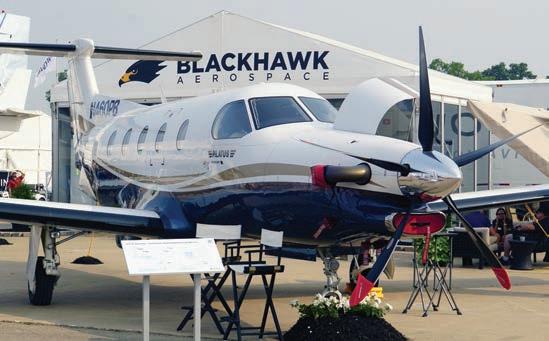
Blackhawk Aerospace has purchased a TBM 700 testbed aircraft (not shown above) in preparation for flight testing of the Pratt & Whitney Canada PT6A-66D engine for a future upgrade program. At EAA AirVenture, Blackhawk CEO Jim Allmon told AIN that the company hopes to have the modified aircraft on display next year at AirVenture. He said the engine upgrade revealed at the 2023 show should boost a modified TBM 700’s cruising speed up to around 295 knots—nearly a 10-knot improvement.
Details regarding plans for the upgrade are still being formulated, but it is likely that the modifications specialist will work with American Aviation on a revised engine inlet and with Blackhawk sister company Avex, a long-time TBM dealer and service center. Allmon estimated the market for a potential TBM 700 upgrade at approximately 380 aircraft
Flexjet Boosts MRO Capabilities with Flying Colours Purchase
Flexjet has continued to expand its maintenance capabilities with the purchase of Canadian MRO provider Flying Colours. The move follows Flexjet’s acquisition earlier this year of affiliated company Constant Aviation. Flexjet’s maintenance network now includes 12 primary facilities and 30 AOG teams. Based in Peterborough, Ontario, and with a facility at Spirit of St. Louis Airport in Missouri, Flying Colours offers a full range of MRO services as well as newly enhanced aircraft completions and refurbishment capabilities. At Peterborough, the company recently opened a 61,000-sq-ft completions hangar, allowing it to handle multiple projects simultaneously, while its new 40,000-sq-ft paint hangar can accommodate aircraft up to the size of airliners.
AIN STAFF
The 250 Flying Colours employees will join Flexjet, including president and CEO John Gillespie, who will oversee completions strategy within the company’s global network.
Leonardo Breaks Ground on $65M Florida MX Base
Leonardo broke ground in July on a $65 million, 113,000sq-ft helicopter maintenance facility at Whiting Aviation Park in Milton, Florida. The complex will provide major component repair and overhaul and transmission testing and repair, along with tooling and a full-sized paint booth. The property will also incorporate a warehouse for spare parts as well as four large hangar bays and a dynamic test bench.
Primarily intended to support the U.S. Navy’s growing fleet of TH-73A “Thrasher” training helicopters, the maintenance facility, which is expected to open at the end of 2024, will also provide services for commercial customers operating throughout the Gulf of Mexico.
Gulfstream Adds MRO Options in China
Gulfstream Aerospace added three authorized warranty facilities in China to replace its support operations at Beijing Capital Airport, the company said. Deer Jet in Beijing, Business Aviation Asia in Shenzhen, and ExecuJet Haite Aviation Services China in Tianjin now serve as authorized warranty repair and maintenance service providers for Gulfstream.
The facilities join Gulfstream’s previously authorized warranty locations in the region, including Metrojet in Hong Kong and Shanghai Hawker Pacific in Shanghai. Regional factory-authorized service centers include Jet Aviation locations in Hong Kong and Singapore.
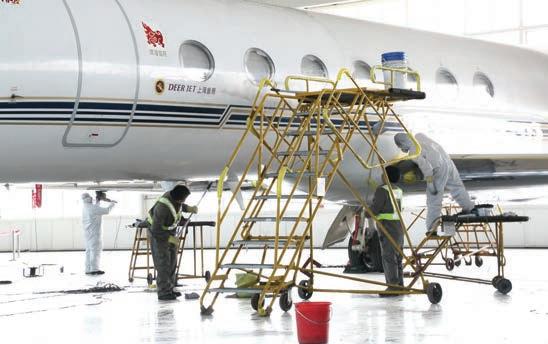
Aviation International News \ September 2023 \ ainonline.com 52
MRO
BY
ANNUAL CORPORATE AVIATION LEADERSHIP SUMMIT


Bringing together a trusted group of corporate aviaton leaders in a private, invitaton-only setng.
Corporate Aviaton Leaders: During this fully-hosted event, collaborate with peers, meet with OEM and aviaton service providers, and hear from thought leaders during leadership sessions, peer breakouts, and curated networking to discuss the growing complexites of corporate aviaton.
Flights, hotel, onsite meals, and registraton are provided for all qualifed atendees.
Sponsors: The Corporate Aviaton Leadership Summit is a curated event that places you right in front of veted decision-makers without the long nurturing process.
Sponsors will have guaranteed one-on-one meetngs, plus board room style presentatons to high level decisions makers. Additonal sponsorship opportunites are available to raise your companies awareness. The number of sponsorships will be limited.
Submit an applicaton to atend Submit an applicaton to sponsor Learn more at: ainonline.com/cals
Accidents
BY DAVID JACK KENNY
Preliminary Reports
Citation Approach Accident Claims Six
Cessna 550, July 8, 2023, Murrieta, California
All occupants of the 1979-model Cessna Citation 550 were killed when the airplane crashed at about 4:15 a.m. during a second attempted instrument approach to French Valley Airport.
A marine layer had enveloped the airport in dense fog, but after executing a missed approach, the pilot requested clearance for a second attempt rather than diverting to an alternate airport. The airplane struck the ground about 500 feet short of the runway, creating a 200-foot-long debris field, and was almost entirely consumed by fire.
The flight had departed Las Vegas’s Harry Reid International Airport about one hour earlier. French Valley airport has a single runway and is served by a single GPS approach procedure. Depending on aircraft equipment, the minimum descent altitude for straight-in approaches ranges from 250 to 521 feet agl.
Three Walk Away After Emergency Autorotation
Hughes 369D, July 9, 2023, Waldorf, Maryland
All three occupants escaped with only minor injuries after a sudden malfunction ended their powerline inspection flight. The Hughes 369D sustained substantial damage, including a rotor strike that severed the tail boom, in a forced landing next to a pond in a residential neighborhood.
After two hours of uneventful flight, the observer in the rear seat heard what he described as “an abnormal noise.” The pilot
and the other observer agreed the noise was “suspicious” but did not initially conclude it was “abnormal.” However, after the pilot noticed “a vibration in the collective,” they chose to abort the remainder of the inspection and return to their base at Maryland Airport in Indian Head (2W5).
Company GPS track data showed the flight heading southwest at a steady altitude of 900 feet and 100 knots groundspeed for about eight minutes before suddenly entering a steep, descending left turn. The track ended at the accident site.
Crew members reported a “loud bang or pop noise and a hard left yaw,” prompting the pilot to enter an emergency autorotation. Home security footage showed the tail rotor striking the surface of the pond as the pilot flared for landing, causing the main rotor to hit the tail boom. The helicopter’s skids flattened the fence surrounding the pond and the ship came to rest upright with engine running. The pilot shut it down and the crew evacuated without assistance.
Six Perish in Mount Everest Sightseeing Crash
Airbus Helicopters AS350 B3E, July 11, 2023, Mount Everest, Nepal
An air tour to Mount Everest crashed just north of Kathmandu during its return flight, killing the Nepali pilot and all five passengers, who were reported to be Mexican citizens. Air traffic control lost contact with the flight as the AS350 B3E descended through 12,000 feet. Weather at the time of departure was described as good, but the accident occurred during Nepal’s monsoon season, and press reports quoted one official at the Kathmandu airport as saying that the pilot had changed course to avoid low weather.
Thirteen Casualties at Polish Airfield
Cessna 208B, July 17, 2023, Chrcynno, Poland
Five people including the Cessna Caravan’s pilot were killed and eight others injured, two of them critically, when the jump plane crashed into a hangar during what was reported to have been stormy weather. All the victims except the pilot had gone into the hangar to take shelter from the storms.
Unconfirmed accounts indicate that the pilot flying was a flight instructor who lost control during a touch-and-go; two other pilots undergoing training were also on board, but survived.
It was not initially clear whether the surviving pilots were among the injured. Multiple sources cited this as Poland’s worst skydiving-related accident since 2014, when the crash of a Piper Navajo near Topolow killed eleven.
Final Reports
Meridian Lost in Apparently Botched Missed Approach
Piper PA-46-500TP, Dec. 10, 2021, Steamboat Springs, Colorado
Archived ADS-B track data indicated that the solo pilot began the left turn of the missed approach procedure just after passing the last stepdown waypoint but did not initiate the charted climb. Shortly afterwards, the Piper Meridian single-engine turboprop crashed into a mountainside at an elevation of 8,172 feet, killing the pilot. The accident occurred in night conditions at 18:09 local time. Weather reported at the airport, at elevation 6,882 feet msl, included a 1,200-foot overcast layer with only 1 mile
Aviation International News \ September 2023 \ ainonline.com 54
The material on this page is based on reports by the o cial agencies of the countries having the reponsibility for aircraft accident and incident investigations. It is not intended to judge or evaluate the ability of any person, living or dead, and is presented here for informational purposes.
visibility, suggesting the pilot was also in actual instrument conditions throughout the attempted approach. The reported visibility was below approach minimums for all aircraft categories.
The flight departed from Cody, Wyoming, about 17:05 on an IFR flight plan to Steamboat Springs. There is no record of the pilot having obtained a specific weather briefing, but a general route briefing ForeFlight provided when he filed his flight plan included a Metar report of 7 miles visibility below a broken ceiling at 4,500 feet agl. The en route portion of the flight was uneventful, and at 17:57 the pilot was cleared for the RNAV (GPS)-E approach to Runway 32.
The procedure requires a series of stepdowns, with minimum altitudes of 9,700 feet at the final approach fix and 8,740 feet at the WAKOR waypoint 2.2 nm from the runway threshold. Descent to the minimum descent altitude of 8,140 feet (1,258 feet agl) is authorized after passing WAKOR, and the Runway 32 threshold is the missed approach point. The missed approach procedure begins with a climbing left turn to 11,300 feet en route to a hold at the initial approach fix.
The ADS-B track showed that the airplane crossed the final approach fix at about 9,100 feet and WAKOR at 8,200 feet. Just after passing WAKOR, still two miles outside the missed approach point, it began a 180-degree left turn while descending to 7,850 feet, then started to climb. The last ADS-B return was recorded 3.5 miles north of the crash site at an altitude of 8,125 feet.
The 43-year-old private pilot held an instrument rating and had received the required endorsements to operate a pressurized high-performance airplane. His logbook showed 581 hours of total flight experience that included 45.5 hours in actual instrument conditions and 45.3 hours of simulated instrument time. His night-flying time was not totalled and could not be determined from the two pages of his logbook excerpted in the investigation docket, but the last five entries were all logged as night time.
RCAF Training Crash Traced to Defective Seat Pins
AgustaWestland CH149 Cormorant, March 10, 2022, Gander, Newfoundland, Canada
Locking pins that were shorter than required by specification allowed the pilot’s seat to slip some 12 cm (4.7 inches) from its highest to lowest position during a hover exercise, causing an unrecoverable loss of control. All six crew members were injured, two seriously, and the CH149 Cormorant destroyed when the helicopter spun into the ground at the intersection of Runways 21 and 31 at Gander International Airport.
The accident occurred at the end of a training flight from the Royal Canadian Air Force (RCAF) 9 Wing Air Force Base focused on overland search and rescue operations. During a right pedal turn while hovering over the runway intersection, the pilot’s seat slipped, causing the collective to dip momentarily.
The pilot, thinking the helicopter had banked right, “overcorrected to the left” and applied full left pedal, causing “an accelerated counterclockwise left yaw” that rotated the helicopter about 400 degrees with an increasing right roll before “the right outboard wheel, the right horizontal stabilizer, and the main rotor blades impacted the runway near simultaneusly.”
The pilot reported having done a “wiggle check” before the flight, rocking the seat back and forth to make sure it was secure. The investigation also found that the seat’s dual lever control assembly was “likely” out of adjustment, increasing the likelihood of the pins not locking securely. The RCAF report did not address how non-conforming locking pins came to be installed in the aircraft.
Runaway Conquest Collides with Hangar
Cessna 441, Dec. 13, 2022, Liberal, Kansas
The solo pilot’s decision to leave the cockpit with the engines running ended with the
unoccupied Cessna Conquest taxiing into a hangar, resulting in “substantial damage to the fuselage” concentrated in the nose area. The aircraft was operated under a Part 135 charter certificate; the pilot was preparing to depart on a Part 91 positioning flight. He told investigators that he’d performed his preflight inspection about two hours earlier and did not do another walk-around before boarding.
After starting the engines, he found that the airplane would not move forward. He “thought he set the brakes,” set both engines to idle, and climbed out of the cockpit.
The nose gear was chocked; when he pulled the chocks, the Conquest immediately began rolling forward. He narrowly avoided being struck by the left propeller and “jumped ahead of the airplane,” ran around the left side of the fuselage, and unsuccessfully attempted to re-enter the cockpit. He then watched it taxi across the ramp into a hangar.
The 73-year-old commercial pilot had 21,500 hours of career experience, including 150 hours in the preceding 90 days. He was not only rated in single- and multi-engine airplanes and helicopters, but held instructor ratings for single- and multi-engine airplanes and instrument instructor ratings in both airplanes and helicopters.
During a telephone interview, he told the NTSB investigator that “I have no idea what I was thinking when I decided to leave the engines running. I lost sight of the big picture when I chose to get out of the airplane with them running. I was not in a rush and was not being pressured by time. I should have done an additional walk around.” z
ainonline.com \ September 2023 \ Aviation International News 55
Your source for aviation news! YOUR SOURCE FOR AVIATION NEWS www.ainonline.com www.ainonline.com/alerts E - NEWSLETTER FOR BUSINESS AVIATION www.ainonline.com/subscribe AERO DEFENSE INDUSTRY E - NEWSLETTER www.ainonline.com/subscribe AIR TRANSPORT INDUSTRY E - NEWSLETTER alerts AIN logo: C 0 M 100 Y 63 B 12 Hex: D31245 RGB: R 211 G 18 B 69 Alerts: 65% black font: Myriad Pro semi extended 90% height AINonline logo Get the latest bizav news !
Compliance Countdown
BY GORDON GILBERT
JUST AROUND THE CORNER
Sept. 16, 2023
U.S.: Remote ID of Unmanned Aircraft
Amended FAR Part 89 (Remote Identification of Unmanned Aircraft) required that after Dec. 16, 2022, no unmanned aircraft can be produced without FAA-approved remote identification capability. After Sept. 16, 2023, no unmanned aircraft can be operated in U.S. airspace unless it is designed and produced to meet the minimum performance requirements for standard remote identification or transmitting ADS-B Out under Part 91.
Nov. 8, 2023
Canada: ADS-B Transition Period
Implementation of the Canadian ADS-B mandate in Class A airspace went into effect August 10, but continued supply chain issues has prompted Nav Canada to provide a 90-day transition period until November 8. Aviation occurrence reports will not be filed during this transition period in the event that an aircraft is not equipped or has not received an accommodation agreement to enter airspace where ADS-B is mandatory. Post November 8, Nav Canada will continue to assess accommodation requests and strive to clear aircraft unable to transmit ADS-B similar to circumstances where aircraft without functioning transponders request entry into transponder mandatory airspace.
Dec. 31, 2023
Europe: Emissions Trading System
Some two years after the European Commission’s proposal to revise aviation’s Emission Trading System (ETS) directives, revisions have been adopted and must be incorporated into the legislation of EU members states by Dec. 31, 2023. Key changes noted by EBAA include the gradual phasing out of free ETS allowances starting in September 2024 to reach a full auctioning regime beginning in 2026. Beginning in 2025, covered operators will be required to report non-CO2 emissions, such as oxides of nitrogen (NOx), soot particles, oxidized sulfur species, and effects from water vapor (contrails).
April 24, 2024; Oct. 24, 2024; April 25, 2025
U.S.: Airport SMS
Certain air carrier airports certified under FAR Part 139 will be required to submit an implementation plan for a safety management system (SMS) on the following deadlines: April 24, 2024 for airports designated as hubs; Oct. 24, 2024 for airports with 100,000 or more annual operations over the previous three years; and April 25, 2025 for airports classified as port of entry, landing rights, user fee, and international facilities. In each case, the SMS must be implemented no later than 12 months after receiving FAA approval of the certificate holder’s implementation plan. Most general aviation airports will be able to obtain a waiver from the SMS requirement.
Sept. 9, 2024
U.S.: Pilot Records Database
Final compliance date is Sept. 9, 2024 for reporting historical records concerning training, alcohol testing, qualification, proficiency, and disciplinary actions records that date before Jan. 1, 2015, to the new pilot records database (PRD). Also beginning on Sept. 9, 2024, the Pilot Records Improvement Act (PRIA) ceases to be effective and will not be an available alternative to PRD. Also after this date each entity that holds an operating certificate under Parts 121, 125, or 135 or that holds management specifications for Part
91K must report to the PRD all historical records kept in accordance with PRIA dating from Aug. 1, 2010, until June 10, 2022. Since June 2023 operators under Parts 91, 91K, and 135 were required to complete submissions to the PRD of all historical records dating on or after Jan. 1, 2015.
Dec. 2, 2024
Europe: Part 145 SMS
Starting on Dec. 2, 2022, EASA Part 145 maintenance organizations were required to meet revised regulations. However, there is a two-year transition period, to Dec. 2, 2024, to allow them to correct any findings of noncompliance with the new Part 145 requirements. The main change is the required implementation of a SMS.
Dec. 31, 2025
Europe/UK: Portable Halon Fire Extinguishers
In 2010, both EASA and the UK Environmental Agency set Dec. 31, 2025 as the replacement deadline for the use of Halon handheld portable fire extinguishers in aircraft cockpits and cabins, as well as in certain aircraft fire-protection systems. The deadline, applicable to the current fleet as well as newly manufactured aircraft, was set years ago as part of a long-time effort to reduce ozone levels. ICAO adopted halon replacement deadlines in 2011, and the Underwriters Laboratories withdrew its standard for halon-based handheld
Aviation International News \ September 2023 \ ainonline.com 56
NEW NEW
fire extinguishers in October 2014. EASA’s deadline document describes standards for the use of other agents to replace Halons. Although there is no FAA-required deadline, the agency since 2011 (AC 20-42D) explains how to gain certification for clean halocarbon agent portable extinguishers intended to replace Halon 1211 units.
March 31, 2026
Australia: Radio Altimeters and 5G

Starting March 31, 2026, Australianregistered aircraft operators will need to be equipped with radar altimeters that meet minimum performance levels to deter interference by mobile phone 5G service. Before this date, the country’s Civil Aviation Safety Authority (CASA) is working with the Australian Communications and Media Authority (ACMA) to ensure that efforts run smoothly to prevent interference with radio altimeters. CASA is coordinating with ACMA so that the rollout of wireless broadband services, including 5G in the 3.7- 4.0 GHz band, can be done in a way that ensures the safety of aircraft in Australia. Ongoing mitigations after March 31, 2026 will include a 200 MHz buffer between wireless broadband and radio altimeter frequencies as well as limits on power and unwanted emissions.
May 29, 2026
Canada: CVR and Data Link
Multi-engine turbine-powered aircraft configured for six or more passenger seats have been granted a temporary exemption from new cockpit voice and data link recorder requirements that are e ff ective on May 29, 2023. The exemption is due to Covid-related delays in parts production, supply chains, and transportation, as well as labor shortages at manufacturers and installers. This exemption is in effect until the earliest of May 29, 2026, or a date when the exemption is canceled by Canada’s DOT.
For the most current compliance status, see: ainonline.com/compliance
Duncan Aviation is the largest privately owned business jet service provider in the world. With complete Maintenance, Repair and Overhaul (MRO) service o erings at three beautiful US facilities, strategically placed regional shops, and mobile technical teams able to provide services worldwide, we help business aircraft operators get the most value from their aircraft ownership.
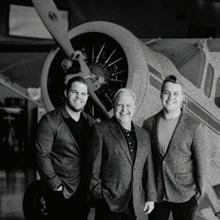
Aircraft Acquisition & Consignment


Airframe Maintenance








Avionics Installation Emergency Assistance (AOG)
Engine & APU
Engineering & Certification Services

FBO Services
Government & Special Programs
ainonline.com \ September 2023 \ Aviation International News 57
Complete Business
Aircraft Services
any other. www.DuncanAviation.aero Visit Us at NBAA | Booth C9008
Paint & Interior Parts, Avionics, Instruments & Accessories Experience. Unlike
BY AIN STAFF
Brent Wouters joined Jet Linx as CEO and Jamie Walker moved over to chairman, focusing on the company’s overall strategic vision, mergers and acquisitions opportunities, and industry and client relations. Wouters, who took his new role on July 31, has 32 years of professional experience including as president and CEO of Iron Valley Supply and of Cirrus Aircraft.
Johann Bordais , president and CEO of Embraer Services & Support, is taking the helm of Eve Air Mobility as CEO, effective September 1. Bordais joined Embraer in 2000 and is credited with turning its services business into a global, rapidly growing, and most profitable unit—last year services accounted for $1.27 billion, or 28 percent of total company revenue.
Women in Aviation International appointed Stephanie Kenyon as interim CEO following the departure of former CEO Allison McKay. Kenyon has more than two decades of leadership experience in the aviation industry having previously served as v-p of the AOPA Foundation. She has served as WAI’s chief growth officer since 2021, where she led the strategic direction and financial growth of the organization.


Flydocs hired Savas Toplama to assume the role of CCO following the transition of John Bowell to senior v-p of engineering services.

Toplama has more than 17 years of experience in aviation and professional services having previously held various positions with Lufthansa Aviation Group and most recently as a manager with Deloitte Consulting. Additionally, the company hired Naveen Mangle as chief digital and technology officer. Mangle has more than two decades of experience in information technology and most recently served as chief technology officer with Fusion Microfinance.
Scott Fuller will retire as airport director of Gulf Shores International Airport (KJKA) on November 1. He will then transition to executive emeritus with the airport authority until
the completion of an ongoing expansion project. Fuller has spent more than 40 years in airport management roles.
Air bp appointed Federica Berra senior v-p. Berra joined bp in June 2020 as senior v-p of integrated gas and power in its gas and low-carbon energy business and previously, she was v-p of acquisitions for Latin America with ExxonMobil.
Comair Flight Services (CFS) promoted Kerry Searle from client services director to managing director where she will guide the daily operations of the company. CFS co-founder and former CEO Justin Reeves has also been elevated to the role of group CEO.
Airshare hired Rob Black and Harvey Murphy as vice presidents of sales. Black was a founding employee at Jet It and most recently served as director of sales. Murphy, who will head the company’s Northeast market, has more than a decade of experience in private aircraft sales at VistaJet, Victor, Blade, and, most recently, FXAir.
Ontic appointed Kairat Asenei as v-p of revenue management. Asenei joins Ontic with experience in revenue management execution and business strategy design following a seven-year tenure with global management consulting firm McKinsey & Company where he most recently held the position of associate partner.

Blueberry Aviation appointed Sofiane Cherchali as v-p of contracts. Cherchali, a qualified solicitor in England and a qualified lawyer in France and Spain, has previously held positions with Stephenson Harwood law firm, Proparco, Bpifrance, and for French independent solar energy developer and producer TSE.
The Air Charter Safety Foundation hired Alexander Evans as assistant director of safety and Andrew Ha as programs administrator. Evans, previously worked at Flightline Aircraft Services, where he oversaw ground operations and ground security for NFL team charters. Ha holds a commercial pilot certificate with an instrument rating and interned at Allegiant Airlines.
Aviation International News \ September 2023 \ ainonline.com 58
FEDERICA BERRA
KAIRAT ASENEI
JOHANN BORDAIS
in Aviation
STEPHANIE KENYON
People
Elite Jets promoted former director of operations Matt Simpson to chief pilot, succeeding Paul Scott , who will continue as a pilot for the company. Simpson, who captains the Phenom and Legacy, has logged nearly 20,000 flight hours. Rodney Beeler, who served as assistant director of operations, will assume the role previously held by Simpson. Beeler is a military veteran with an ATP of more than 8,000 flight hours.
ACI Jet MRO promoted Jonathan Carlyle to repair station manager and appointed Michael Johnson and Joe Borchers as project managers. Carlyle has prior experience at Textron and Bombardier facilities in various maintenance roles. Johnson has nearly two decades of experience at a Textron Aviation service center as an aircraft technician and team lead. Borchers joined ACI Jet in 2018 as an A&P mechanic. z
AWARDS AND HONORS
The Florida Department of Transportation named Chris Rozansky—executive director of Naples Airport Authority (NAA)—as its 2023 Aviation Professional of the Year. The award recognizes Rozansky for his “involvement in Florida aviation during the previous year and his continuing commitment and significant achievements in the industry.” He has served as the NAA executive director for seven years.
Mike Atwood—founder and CEO of Aviation Specialties Unlimited (ASU)—was honored by the Airborne Public Safety Association for his “longstanding and continuing dedication to airborne law enforcement safety.” Atwood founded ASU in 1995 with the goal of bringing night vision goggles (NVGs) to the civilian emergency medical services market. In 1999, the FAA authorized NVGs for EMS personnel use. Since then, ASU has supplied more than 5,000 NVGs to EMS operations worldwide.
Chauncey Frank Webb , a long-time corporate pilot and former naval aviator, died July 21 at the age of 76. Webb had a career spanning more than five decades flying helicopters and fixed-wing aircraft for the U.S. Navy, corporate flight departments, and private aircraft owners.

Born Oct. 22, 1946, in Bay City, Texas, Webb became interested in aviation in his youth and would get scolded because he became distracted and stared out his school windows to watch airplanes take o from a nearby airport. He hung out at the airport and asked to wash airplanes for rides. His interest further heightened after his older brother, Randol Webb, Jr., enlisted in the U.S. Air Force and flew A-1 Skyraiders in the early years of the Vietnam War.
After graduating from Bay City High School in 1965 and Sam Houston State in 1969, Webb attended Naval Aviation O cer Candidate School in Pensacola, Florida, to pursue his passion for flying.
He earned his wings and reported in October 1971 to the all-volunteer Helicopter Combat Support Squadron 7 (HC-7), known as Sea Devils, at NAS Imperial Beach, California. The unit was dedicated to combat search and rescue and included missions over land and in the waters of North Vietnam. In that unit, he flew Sikorsky HH-3 helicopters from naval vessels in the Gulf of Tonkin and became helicopter aircraft commander. He later trained pilot candidates, joined an anti-submarine
warfare unit flying the Sikorsky SH-3 Sea King as an aircraft commander, and served on the USS America.
In 1979, he retired from active duty and turned to civil aviation, with jobs that ranged from aircraft sales and charter work in Northern California to training in the Sikorsky S-76. He flew an S-76 in Costa del Sol, Spain for a wealthy sheik but returned to Northern California to fly a Bell 222 for Warner Communications (Atari Division).
Webb ultimately joined American Express, where he would spend his next 20 years flying its S-76 and later the Gulfstream IV and V.
He also had an a nity for general aviation, flying aircraft from Piper Cubs to the gamut of Cessna single-engine models, in addition to floatplanes, warbirds, Stearmans, and Wacos. “If a brick had wings, Chauncey could fly it," a buddy said of Webb.
Leaving American Express in 2003, he joined an aircraft management company and flew a Falcon 900 for the principal of a real estate investment company for the remainder of his years.
Webb is survived by his wife of 44 years, Jane, who is a former AIN employee, as well as his daughter, Genny Drash, son-inlaw, Wayne Drash, and grandchildren, Emma and Billy Drash.
Those wishing to honor Webb can donate to the EAA Aviation Foundation, specifying the Young Eagles. A celebration of life is planned for 11 a.m. October 3, at the Cayton's Bistro at the Ritz in Marana, Arizona. Contact CFWMemorial@gmail.com to RSVP.
ainonline.com \ September 2023 \ Aviation International News 59
MATT SIMPSON
Another Model 25 derivative was the Learjet 28/29 Longhorn of 1977, with an all-new wing design. Although only nine were built, it was the first production jet to feature winglets. These were carried forward to the Model 55 and improved Model 60, which had larger cabins. The Learjet 31, introduced in 1990, married the Longhorn wing with the fuselage of the 35/36 and was the ultimate expression of the original design sequence initiated by the Model 23.
Under Bombardier’s stewardship, a new family of Learjets was developed. While unmistakably continuing the design tradition, they were all-new aircraft. The first was the 45, which led to the shorter 40, and then the modernized 70/75. A final development, the composite Learjet 85, was canceled 18 months after its first flight.
During this period the company underwent a number of changes in name and ownership. In November 1964 it became publicly owned, but Lear was forced to sell his 60 percent share in April 1967 to Gates Rubber. He remained on the board until April 2, 1969, at which point the company adopted the name Gates Learjet.
As for Lear himself, he remained interested in business aircraft, developing the LearStar 600 design in the mid-1970s. The concept was acquired by Canadair (later Bombardier), but by the time the company’s wide-body business jet was launched as the CL-600 Challenger, little remained of Lear’s original design.
Another buyout in 1987 by Integrated Acquisition resulted in a change to Learjet Corporation before the company was acquired by Bombardier Aerospace in 1990. On Feb. 11, 2021, Bombardier announced the end of Learjet production after nearly six decades, and on March 22, 2022, the final aircraft was delivered. The Learjet name had been carried by more than 3,000 aircraft and continues to be a major player in the used aircraft market. z
HOLAHAN (1921-2015), FOUNDING EDITOR, WILSON S. LEACH, FOUNDER & CHAIR EMERITUS
EDITOR-IN-CHIEF – Matt Thurber
NEWS EDITOR–AIN PUBLICATIONS – Chad Trautvetter
EDITOR AIN MONTHLY MAGAZINE – Kerry Lynch
SENIOR EDITORS – Charles Alcock – International Editor, Curt Epstein, Gregory Polek – Show Editions, Hanneke Weitering – Technology Editor CONTRIBUTORS
David Donald – Defense, Mark Huber – Rotorcraft , Jennifer Leach English, David Jack Kenny – Safety Gordon Gilbert, Dale Smith, Richard Pedicini, James Wynbrandt
PRODUCTION MANAGER – Martha Jercinovich
GRAPHIC DESIGNER – Grzegorz Rzekos
DIRECTOR OF VIDEO – Ian Whelan
EXECUTIVE CHAIR – Dave Leach
PRESIDENT–Ruben Kempeneer
HEAD OF PEOPLE & BRAND–Jennifer Leach English
VICE PRESIDENT SALES & MARKETING – Karl H. Elken
SENIOR DIRECTOR, INDUSTRY AFFAIRS AND EVENTS– Nancy O’Brien
ADVERTISING SALES
Michelle James – Midwestern U.S., Western U.S./Western Canada/Asia Pacific, +1 (520) 343-0236
Stephanie Robbe – Mid-Atlantic U.S./Southeast U.S./Caribbean/Brazil, +1 (508) 985-8666
Diana Scogna – Europe/Middle East, +33 6 62 52 25 47
Victoria Tod – Northeastern U.S./Eastern Canada/Great Lakes U.S./United Kingdom, +1 (203) 733-4184
AUDIENCE DEVELOPMENT DIRECTOR – Eileen Silberfeld
DIRECTOR OF MARKETING AND CLIENT SERVICES – Lisa Valladares
AD OPERATIONS SPECIALIST – Lauren DelNegro
SOCIAL MEDIA MARKETING – Zach O’Brien
SALES ADMINISTRATOR – Cindy Nesline
DIRECTOR OF FINANCE & HUMAN RESOURCES – Michele Hubert
ACCOUNTS PAYABLE – Mary Avella
ACCOUNTS RECEIVABLE – Bobbie Bing
U.S. HEADQUARTERS
214 Franklin Ave., Midland Park, NJ 07432, +1 (201) 444-5075
Advertising Inquiries: +1 (201) 345-0085, adsales@ainonline.com
Circulation Inquiries: +1 (201) 345-0085, subscriptions@ainonline.com
WASHINGTON, D.C. EDITORIAL OFFICE:
Kerry Lynch: klynch@ainonline.com, Tel: +1 (703) 969-9195
EUROPEAN EDITORIAL OFFICE:
Charles Alcock: calcock@ainonline.com, Tel: +44 7799 907595
Aviation International News (ISSN 0887-9877) is published twelve times per year (monthly). Periodicals postage paid at Midland Park, N.J., and additional mailing o ces. Postmaster: Send address changes to Aviation International News, P.O. Box 8059, Lowell, MA 01853 USA. Allow at least eight weeks for processing. Include old address as well as new, and an address label from a recent issue if possible. Subscription inquiries: +1 (201) 345-0085 or email: subscriptions@ainonline.com.
Aviation International News is a publication of AIN Media Group, 214 Franklin Ave., Midland Park, NJ 07432; Tel.: +1 (201) 444-5075.
Copyright © 2023 All rights reserved. Reproduction in whole or in part without permission of AIN Media Group is strictly prohibited. AIN Media Group publishes Aviation International News, AINalerts, AINtv, Business Jet Traveler, BJTwaypoints, ABACE Convention News, Dubai Airshow News, EBACE Convention News, Farnborough Airshow News, FutureFlight.aero, HAI Convention News, LABACE Convention News, MEBAA Convention News, NBAA Convention News, Paris Airshow News, Singapore Airshow News, Mobile Apps: Aviation International News; AINonline. PUBLICATION MAIL AGREEMENT NO. 40649046 RETURN UNDELIVERABLE CANADIAN ADDRESSES TO: PITNEY BOWES INTERNATIONAL MAIL, STATION A, P.O. BOX 54, WINDSOR, ON, N9A 6J5, returns il@imex.pb.com.
For feedback, letters to the editor, or other editorial needs, please contact AIN’s Editors at ainedit@ainonline.com

Aviation International News \ September 2023 \ ainonline.com 60
JAMES
continued from page 20
Cancer Patients Fly Free

Can You Spare a Seat?
Corporate Angel Network (CAN) is a 501(c)(3) nonprofit organization whose mission is to provide cancer patients with free transportation to treatment centers throughout the United States.







CAN works with corporate flight departments to match scheduled business trips with patient requests. Thanks to the generous support of over 500 partners, CAN has coordinated more than 67,000 flights.
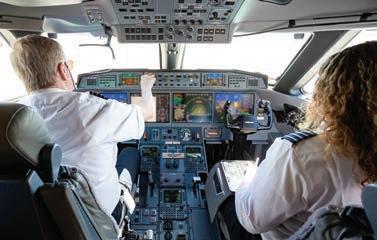
Contact CAN to learn more about becoming a partner or to make a personal or corporate donation to support the mission.

corpangelnetwork.org


































It’s wonderful that
like the Corporate
Network
able to
of
are
Westchester County Airport | White Plains, NY | (914) 328-1313
organizations
Angel
are
help connect those most in need
flights to those who
flying. -Henry Maier, President and CEO, FedEx Ground

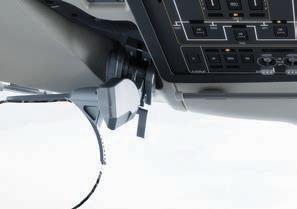
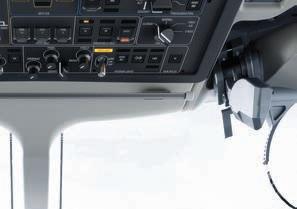


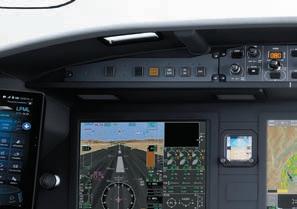































 BY GORDON GILBERT
BY GORDON GILBERT




















































 BY AIN STAFF
BY AIN STAFF






































































































